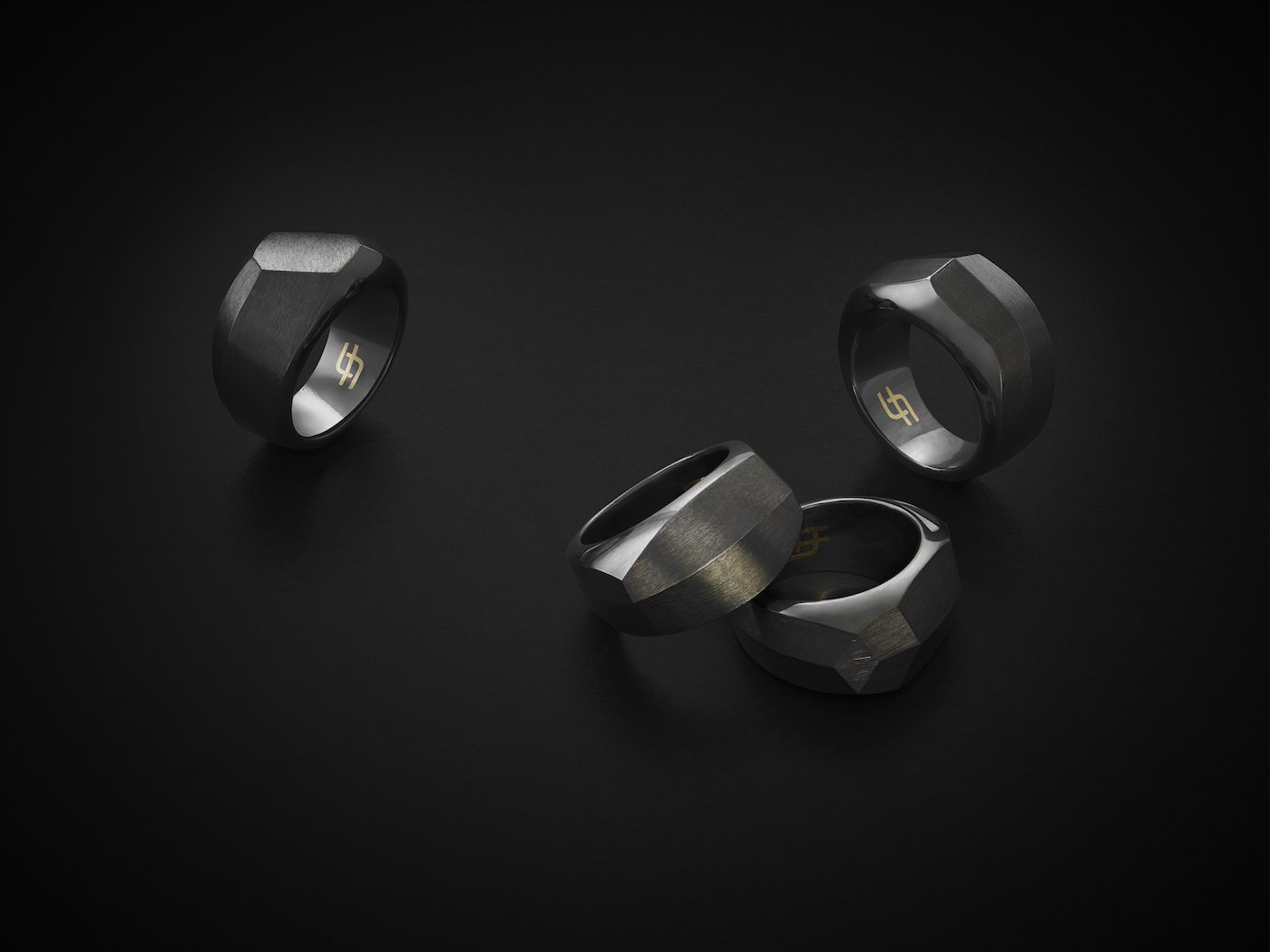

Report: a world tour of jewellery
By Isabelle Cerboneschi

The 1920s, the golden age of jewellery
f there is one decade that profoundly marked and even revolutionised high jewellery, it was the 1920s to 1930s. “This is one of the great eras of jewellery,” says François Curiel, Chairman of Christie’s Europe and Asia. “The great houses of Place Vendôme – Boucheron, Cartier, Chaumet, Van Cleef & Arpels – were extremely active in this period. Everyone wanted to create the best. Until the 1929 crisis hit, the economy was booming: success- ful industrialists were buying jewellery for their wives, and the jewellery business was flourishing.”
“The great houses of Place Vendôme – Boucheron, Cartier, Chaumet, Van Cleef & Arpels – were extremely active in this period. Everyone wanted to create the best.”
Place Vendôme, the new epicentre of fine jewellery
“Although there were also some lesser-known names, such as Black, Starr & Frost, the first American jewellers, Yard or Charlton, which have not survived to the present day, the great jewellers of the time were in Paris,” continues François Curiel. And specifically, in the Place Vendôme.
Previously, the jewellers of Paris were located mainly around the arcades of the Palais Royal – with the exception of Mellerio, which opened its boutique on Rue de la Paix, not far from the Paris Opera House, in 1812. Boucheron’s move to 26 Place Vendôme in 1893 shifted the centre of gravity of high jewellery to the 8th arrondissement of Paris (where Rue de la Paix was located).
-

- Exceptionally rare multi-gem Egyptian revival sautoir, Van Cleef & Arpels, sold by Christie’s Geneva in 2018 for CHF 4,332,500. Old and rose-cut diamonds, rubies, emeralds, onyx, platinum and gold (French marks), 1924.
Before the 1920s, jewellery was a reflection of the romantic spirit of the 19th century. It tended to follow the direction of the arts of the time, with a marked taste for orientalism, naturalism and history. The advent of Art Nouveau at the end of the 19th and beginning of the 20th centuries opened up new avenues of expression for jewellery, with its ornamental forms, arabesques and floral abundance.
After the First World War, everything changed
The First World War changed everything, including the decorative arts. The style, or rather styles, that emerged in the 1920s were the result of several factors.
First of all, the horrors of war generated a need for beauty and a frenzy of desire, whatever the cost. The discovery of the tomb of Tutankhamun in 1922 led to a taste for exotic cultures. The 1925 International Exhibition of Modern Decorative and Industrial Arts saw the emergence of a new style: Art Deco, whose pure geometric forms sounded the death knell for the organic flourishes of Art Nouveau. Finally, we must not forget that, during the war, women had taken on many of the roles traditionally occupied by men, which gave them a strong sense of freedom and possibility. Let us explore some of these influences in more detail.
The 1925 International Exhibition of Modern Decorative and Industrial Arts saw the emergence of a new style: Art Deco, whose pure geometric forms sounded the death knell for the organic flourishes of Art Nouveau.
-

- Scarabée brooch, Cartier London, 1925. Gold, platinum, Egyptian blue earthenware, old and 8/8 round diamonds, ruby and emerald cabochons, citrine cabochons, onyx cabochons. Originally, this brooch could also be worn as a belt buckle. Nils Herrmann, Collection Cartier ©Cartier
1922: discovery of the tomb of Tutankhamun
If there was one event that influenced the jewellery and decorative arts of the 1920s more than any other, it was the discovery of the tomb of Tutankhamun by Howard Carter on 4 November 1922. “From 1923-24, we began to see jewellery coming out of the workshops with motifs inspired by Egypt,” explains Lise Macdonald, director of heritage and exhibitions at Van Cleef & Arpels. “In fact, we asked specialists at the Louvre if they could recognise the hieroglyphics engraved on our jewellery and period objects, but the experts told us these motifs had come from the designers’ imagination, and were devoid of Egyptological meaning.”
-

- Jacques Cartier with stone merchants. Photograph from his travel diaries of 1911
This infatuation with Egypt soon spread to other distant lands, including Japan, China and India, as is perfectly illustrated by Cartier’s Tutti Frutti of 1925. “The first contacts between Cartier and Indian jewellery date back to 1902, the year of the coronation of Edward VII,” explains Pierre Rainero, Cartier’s Director of Image, Style and Heritage. “His wife, Queen Alexandra, had received many gifts from Lord and Lady Curzon, the Viceroy and Vicereine of India. These included jewellery. As we had a supplier’s patent for both Edward VII and Queen Alexandra, she entrusted these jewels to Cartier, to be reassembled in the House style. In the winter of 1911, Edward VII died and George V became the new king. Jacques Cartier was invited to Delhi in December 1911, to celebrate the coronation of King George V and Queen Mary in Britain a few months earlier. He established an office in Delhi to buy Indian engraved stones and export them to Cartier in Paris and London. Tutti Frutti is linked to the existence of this stock of engraved stones.”
-

- Tutti Frutti Bracelet, Cartier Paris, 1925. Platinum, diamonds, sapphires, rubies, emeralds, onyx, black enamel. Sold to Mrs Cole Porter. Nils Herrmann, Collection Cartier ©Cartier
But it’s impossible to talk about Tutti Frutti without mentioning the presence of Jeanne Toussaint at Louis Cartier’s side. “He hired her between 1919 and 1920. Louis Cartier signed the drawings but we think he was strongly influenced by Jeanne Toussaint. When you see the parallel lines of the first Tutti Frutti bracelets of 1925, you immediately think of the Tank watch, with its two parallel stretchers. But in this figurative profusion, we can also guess the style that Jeanne Toussaint would later cultivate. The two figures came together to create a very innovative object,” says Pierre Rainero.
This infatuation with Egypt soon spread to other distant lands, including Japan, China and India, as is perfectly illustrated by Cartier’s Tutti Frutti of 1925.
-

- Jeanne Toussaint photographed by Baron Adolph De Meyer, c. 1920. ©Cartier
1925: the delayed birth of Art Deco
“The 1920s was a richer decade than one might imagine,” continues Pierre Rainero. “This Art Deco period saw the advent of a new creative approach marked by two essential aspects: on the one hand, the influence of geometry, or even abstraction; and on the other, a great curiosity for distant cultures that conveyed a different image of what we thought was beautiful.”
-

- Brooch, Cartier New York, special order, 1925. Platinum, one 15.12-carat cabochon-cut emerald, one 3.83-carat cushion-shaped diamond, coral, black enamel, diamonds. Nils Herrmann, Collection Cartier ©Cartier
This idea of drawing inspiration from other territories – China, Japan, the arts of Islam, Russia and India – can be found at Cartier: “The House proposed aesthetic shocks, new associations of colours and shapes, as well as new ways of wearing jewellery. In reality, this interest in other cultures and the eruption of geometry into the field of jewellery dates back to the beginning of the 20th century. And if its echo was greater after the war, it was precisely because of the conflict. The famous ‘Exposition Internationale des Arts Décoratifs et Industriels Modernes,’ held in Paris in 1925, should have taken place in the early 1910s. This prospect had stimulated the imagination of the designers and made them want to show new things, but their creative work could not be unveiled until 1925. Following this exhibition, Art Deco became one of the first international styles,” explains Pierre Rainero.
“The Art Deco period saw the advent of a new creative approach marked by two essential aspects: the influence of geometry, or even abstraction, and a great curiosity for distant cultures that conveyed a different image of what we thought was beautiful.”
Women were emancipated, and so was their jewellery
While the men were at war, women replaced them, working in factories, driving buses and ambulances, and many other activities. And in order to be able to do this, they had to throw away their corsets. “Even if, from a legal point of view, women did not enjoy the same freedom as today’s women, in terms of behaviour they were freer: they cut their hair into boyish styles, danced the Charleston and changed their silhouette, and jewellery accompanied these changes,” Lise Macdonald points out.
The appointment in 1926 of Renée Puissant, the daughter of the founding couple of Van Cleef & Arpels, as artistic director of the House is a fine example of the new power of women. She worked in collaboration with René Sim Lacaze, a genius designer: “This alliance allowed the House to take off,” continues Lise Macdonald. “Renée Puissant was someone who dared to create new combinations and in the 1920s she steered the House towards more refined, geometric, architectural forms.”
-

- Embracing Flowers bracelet, red and white roses, 1924. Platinum, onyx, rubies, emeralds, yellow and white diamonds. Van Cleef & Arpels Collection
“In the 1920s, people wanted to turn their backs on the war and indulge in all the pleasures of life,” emphasises Pierre Rainero. “Hence a certain extravagance. Women would wear many bracelets stacked together, and long necklaces. They owned beauty kits.”
“Minaudières” or vanity cases were born at that time and have not survived. “I love the ones that Charles Arpels created in the 1920s for Florence Jay Gould, the wife of philanthropist and businessman Frank Jay Gould,” says François Curiel. “Before accompanying her to a party, he had seen her slip her cigarettes, a comb, a tube of lipstick and some money into a simple metal box, because she didn’t want to bother with a handbag. This gave him the idea of creating a precious minaudière, so that she could slip all her accessories into it.”
The appointment in 1926 of Renée Puissant, the daughter of the founding couple of Van Cleef & Arpels, as artistic director of the House is a fine example of the new power of women.
1927: Creation of Europa Star
The Europa Star publishing house was born during this creative decade, in 1927. If one had to pick out a flagship jewellery piece that appeared that year, it would probably be the Chinese Magician watch created in 1927 by Van Cleef & Arpels, says Lise Macdonald: “ This piece is equipped with a Breguet movement with a double retrograde display: one of the magician’s arms gives the hours and the other the minutes. What is important is the technicality of the piece and above all the influence of Asian art. One of these watches belonged to the Maharani of Baroda and another to Mr Breguet.”
-

- Chinese Magician pocket watch, 1927, yellow gold, osmior, enamel, Breguet movement, Van Cleef & Arpels Collection.
“Jewellery from this period is the lifeblood of today’s auctions,” notes François Curiel. “Clients look for these pieces because they are set with stones that are almost impossible to find today: Kashmir sapphires, diamonds from the Golconda mines, untreated emeralds...”
“Jewellery from this period is the lifeblood of today’s auctions.”
-

- An exceptional Art Deco bracelet by Cartier sold by Christie’s Hong Kong in 2016 for HKD 56,120,000 (USD 7,256,316) set with eight graduated cushion-shaped sapphires (10.53 to 3.38 car- ats) and four-stone diamond gallery, 1923, set in platinum.
But the value of the stones is not the only reason why customers are so keen on Art Deco jewellery. With its clean lines, balanced geometry and flawless colours, this style has endured throughout the intervening century. Traces could be seen at the last Watches & Wonders exhibition, which was held in Geneva in April 2022. The style was very present in the Chinese Tank watch, in gold and lacquer, unveiled by Cartier. It was also expressed in a versatile necklace by Piaget with a yellow diamond and spinel, which can be worn in nine different ways. Or in the long necklace with a pendant featuring Gabrielle Chanel on the front and a precious watch face on the back, which would not have looked out of place around the neck of a woman in a flapper dress, dancing the Charleston at the Cotton Club...

“Jewellers are like artists; they capture our moment in time”
ince the very first edition of GemGenève, the fair’s founders have given historian and author Vivienne Becker the opportunity to create a showcase called the “Designer Vivarium”.
Her idea was to create the ultimate destination for jewellery lovers and connoisseurs. Her intention was to show the richness of jewellery, its history, its role in different civilisations and today’s art and craftsmanship, and give the subject the depth it deserves.
With her Vivarium, she gives independent designers, new and rising stars, the opportunity to exhibit their work publicly – sometimes for the first time.
-

- The Designer Vivarium at the GemGenève fair
Europa Star: What kind of up-and-coming creators do you search for?
Vivienne Becker: I look for jewellers or designers that have a strong, singular point of view, and something to say through their jewellery: a message, a strong concept. And also a very well defined visual vocabulary. It must not be at all derivative: I don’t want it to look like anyone else, and also not a bit of this and a bit of that. It must be a singular vision. That’s important. Their work must be innovative, but not new for the sake of being new. And because I’m a historian and love the history of jewellery, I’m particularly drawn to designers who pull the thread through history. I firmly believe you have to understand the past in order to move forward. I look for jewellers who have a great reverence for tradition but who break tradition. I also like innovation in terms of material and technique. I look for a sense of sophistication in craftsmanship. I’m looking for someone who’s taken that to the next level.
“Because I’m a historian and love the history of jewellery, I’m particularly drawn to designers who pull the thread through history.”
-

- Alexandra Jefford: the Meditation Ring
How do you find them?
I don’t know... I have antennae, I see them, I hear about them. Now I’m lucky, as lots of people write to me: Studio Renn a few years ago, Saurabh Bhola too.
All the designers invited to the Vivarium come from different countries and backgrounds, but do you feel there is a link between them?
Somehow a theme has emerged this year: in November 2021, the work was very innovative and experimental but in 2022, there’s a kind of refined classicism.
-

- Cora Sheibani: Butterfly earrings and Cactus Head ring
How do you explain that new classicism?
Ideas are in the air. Jewellers are like any good artist or designer; they capture our moment in time. Sometimes it’s unconscious, it’s instinctive. We live in times of uncertainty and people turn to the classics. I think it has something to do with these difficult times. During the last ten years or more, high jewellery has been full of colours, very complicated. I think we are going back to more diamonds and quieter hues. That’s just the normal cycle. These jewellers have all, in their own way, reinvented some element of classicism.
“During the last ten years or more, high jewellery has been full of colours, very complicated. I think we are going back to more diamonds and quieter hues. That’s just the normal cycle.”
-

- Vivienne Becker
You are a curator of these artists, but also a kind of fairy godmother to them. By inviting them to the Vivarium in GemGenève, you give them the opportunity to exhibit their work publicly, sometimes for the first time. Do you follow them afterwards?
Yes. I’m thrilled that the Designer Vivarium has been a launchpad for some designers. But the reason we renamed it “Vivarium” is because Vivarium jewellery is my new project: it’s a venture. My business partner Diana Cawdell and I will be representing these jewellers. What I really want to do is combine small private sales exhibitions with new ways to educate, with talks and discussions, so that we can set the jewellery in a social, cultural, historical, and fashion context. Jewellery is a complex subject, and I think the more people understand about it, the more empowered they are to buy and enjoy the jewels. We are working on a collaboration with Phillips auction house and their private jewellery sales department.
Because of Covid, we had to do events online. The first one, named “Woman to Woman”, featured all female designers from the 20th and 21st centuries. We had jewellery from Suzanne Belperron, Elsa Peretti and Paloma Picasso, as well as some of my contemporary designers like Alexandra Jefford and Hannah Martin. It was a huge success, the lots sold well. The second one was on “New Modernism”, tracing the Modernist movement from the 1920s to the 2020s, because I feel there is a whole new modern movement that’s going on now.
“Vivarium jewellery is my new project: it’s a venture. My business partner Diana Cawdell and I will be representing these jewellers.”
Why did you create this project for independent designers?
I’ve had this idea for a long time. I wanted to focus on contemporary jewellers and talk about their work, as I felt the designers I met didn’t have the right platform. The big brands have such marketing power! It’s so difficult for individual designers to compete with that and find their voice and their place in the market. It took me a long time to shape it and formulate it. We are looking for different venues. We are planning pop-ups for the designers in London and hopefully in Paris. Vivarium is finally a brand! It was born from GemGenève.
-

- G. Suen: The Chimera earrings
Do you have the feeling that after globalisation, we live in a time when people and especially creators are going back to their roots?
Definitely. But that’s part of a mega trend. People are more nationalistic, they are taking pride in their roots. It’s a good thing. And of course the other side to that is that, whereas we used to take references from everywhere, now that’s called appropriation. I keep an eye on that.
The craftsmanship of jewellery has barely changed at all. We could assume that we’ve seen it all, but that’s so untrue!
That’s why I’ve done what I’m doing for so many years! These designers keep the jewellery industry alive and dynamic. There are a lot of new techniques now, like 3D modelling. It has changed everything in terms of volume. And there are new materials too: titanium has been around for a while, carbon fibre as well. And have you seen the beautiful Sweet Pea brooch by Saurabh Bhola? He’s using an amazing new ceramic! The brooch is so classical but he used painted ceramic to make it modern. And Oktaaf used artificial intelligence to create their cufflinks. That’s what I mean by capturing the spirit of our time!
“We are planning pop-ups for the designers in London and hopefully in Paris. Vivarium is finally a brand! It was born from GemGenève.”

Chanel’s “1932” collection, a precious tribute
n 1937, Gabrielle Chanel decided to rent a room at the Ritz in Paris. From her balcony, she had a panoramic view of all the hôtels particuliers or private mansions in the Place Vendôme, especially those housing the great jewellers: Chaumet in the Hôtel Baudard de Saint-James at No. 12; Boucheron, in the Hôtel de Nocé at No. 26; Van Cleef & Arpels in the Hôtel Ségur at No. 22; and Cartier and Mellerio were not far away, at No. 13 and No. 9 rue de la Paix respectively.
Was this her way of looking down her nose at them? Perhaps... Five years earlier, Gabrielle Chanel had had a run-in with the great jewellers of the Place Vendôme. The reason was a collection of diamond-set jewellery signed Chanel, which had been commissioned by the Diamond Corporation Limited of London with a view to boosting diamond sales.
-

- Article on “Bijoux de diamants” published in VU in November 1932.
“Sales of diamonds had been badly hit by the economic crisis of 1929, and they put their trust in the creative talent of Gabrielle Chanel, then at the height of her fame, to revive them. With her contemporaries – the artist Paul Iribe for the design of the jewellery, the poet Jean Cocteau for the collection manifesto, and Robert Bresson (later a celebrated film director) for photographs of the pieces – Gabrielle Chanel created a collection that was unique. It caused a sensation at the time and still today it remains the cornerstone of our jewellery designs,” explains Marianne Etchebarne, Chanel’s International Director of Product Marketing, Client and Watch and Jewellery Communication.
The International Guild of Diamonds’ idea to approach Coco Chanel was brilliant: the Guild provided the stones and covered all the production and publicity costs, leaving the designer to revolutionise the genre.
An ultimatum from the jewellery establishment
This collection, simply titled “Bijoux de diamants”, was designed by Coco Chanel with her lover Paul Iribe. Together, they created pieces of unique beauty, such as necklaces without clasps, rings that wrapped around the fingers and the ‘fringe’ necklace. “If I chose diamonds, it is because they represent, with their density, the greatest value in the smallest volume,” the couturière told the press when asked about her motivation. The International Guild of Diamonds’ idea to approach Coco Chanel was brilliant: the Guild provided the stones and covered all the production and publicity costs, leaving the designer to revolutionise the genre.
-

- Press article on “Bijoux de Diamants” published in VOGUE France in January 1933.
The exhibition was to be held from 7 to 19 November 1932 in Mademoiselle Chanel’s mansion at 29 Faubourg Saint-Honoré. The price of admission was set at 20 francs and the money raised from ticket sales was to be donated to two charities. But no one could have foreseen the ire of the major jewellers. Informed by an article published on 26 October in L’Intransigeant, the representatives of the Chambre syndicale de la haute joaillerie decided to put a stop to the exhibition, which they considered unfair. And so a delegation of jewellers sent an ultimatum to Gabrielle Chanel, ordering her not to sell any jewellery, and to dismantle the pieces after the exhibition, under their supervision. Moreover, part of the entrance fee was to be donated to the work of the Chambre Syndicale.
“Look at these comets whose heads shine on one shoulder...”
It would be an understatement to say that these demands were not met. The exhibition did take place and it was a success. The value of the collection was estimated at 93 million francs at the time, and the borrowed diamonds at 50 million. More than 30,000 visitors flocked to admire these original creations in the form of comets, feathers, bows and cascades of diamonds, worn by wax models.
A delegation of jewellers sent an ultimatum to Gabrielle Chanel, ordering her not to sell any jewellery, and to dismantle the pieces after the exhibition, under their supervision. These demands were not met...
“Gabrielle Chanel took the principles that made her celebrated in the world of couture and applied them to jewellery, highlighting the way the pieces were worn and how they moved by displaying them on eerily lifelike wax mannequins, complete with make-up and hats, which meant women could immediately visualise themselves wearing the pieces,” emphasises Marianne Etchebarne. “In a world that was deeply masculine, Gabrielle Chanel was a woman who designed for women. In her view jewellery should be an idea, not a status symbol of the men who bought it for novative move, she made her jewellery part of her global vision for her Maison, imbuing it with her flair for pared-back elegance, her love of monochrome designs and her instinctive desire for the authenticity of the materials she used – in this case platinum and diamonds, the most precious of all.”
“Some of my necklaces don’t close, as the shape of the neck requires; some of my rings roll up,” said Mademoiselle Chanel. The settings were simplified to highlight the stones. “I wanted to cover women with constellations. Stars of all sizes. Look at these comets whose heads shine on one shoulder and whose glittering tails fall in a shower of stars across the chest!” the couturier confided to L’Intransigeant. Some of the jewellery was sold. Chanel was able to buy back a star brooch that is now part of its heritage.
-

- Portrait of Gabrielle Chanel. © George Hoyningen - Huene/Condé Nast via Getty Images
A founding episode for Chanel jewellery
In homage to this collection, 90 years on Chanel is launching a high jewellery collection called the “1932” Collection. “Patrice Leguéreau, Director of the Chanel Jewelry Creation Studio, has retained the comet, the moon and the sun. The theme of these celestial bodies remains highly symbolic as they are found on the paved floors of the convent at Aubazine where Gabrielle Chanel spent part of her childhood. Thus the comet becomes a shooting star, the moon seems to shimmer and the sun radiates,” explains Marianne Etchebarne.
-

- The centrepiece of the “1932” Collection is the Allure Céleste necklace in white gold set with diamonds, which features an exceptional oval-cut sapphire weighing 55.55 carats in its centre.
The centrepiece of the 81-piece set has already been released. The Allure Céleste necklace in white gold set with diamonds features an exceptional oval-cut sapphire weighing 55.55 carats in its centre. Various elements of this transformable necklace can be detached to become brooches or a bracelet. While the original collection was entirely dedicated to diamonds, the 1932 collection also highlights coloured stones, including blue sapphires, yellow diamonds, rubies, spinels and opals.
-

- Chanel 1932 Collection Allure Céleste necklace in white gold and diamonds with a 55.55 ct. oval-cut sapphire, 8.05 ct pear-cut diamond D FL (Type IIa) and a 2.52 ct brilliant-cut diamond D FL (Type IIa).
Gabrielle Chanel never had the opportunity to see her name inscribed on the pediment of the Hôtel Duché des Tournelles, at number 18, Place Vendôme, just opposite the Ritz Hotel. This is the address of the Chanel Joaillerie boutique that opened its doors in 1997. Finally, she has found her place among the great names in jewellery.
While the original collection was entirely dedicated to diamonds, the 1932 collection also highlights coloured stones, including blue sapphires, yellow diamonds, rubies, spinels and opals.

Van Cleef & Arpels: philosophy begins with wonder
uring the Watches & Wonders exhibition from 30 March to 5 April in Geneva, one stand was the talk of the town: that of Van Cleef & Arpels. At a time when everyone’s morale had been affected by the war in Ukraine, which had broken out a month earlier, the Parisian jeweller welcomed its visitors into a world of enchantment.
It was a place where automata had the power to momentarily transport the mind into another world, a universe where craftsmanship, poetry and beauty reigned and where time was read with flowers. The quote by Aristotle, “Philosophy begins with a sense of wonder,” could have been written for Van Cleef & Arpels.
It’s been almost ten years since Nicolas Bos was appointed President and CEO of the brand, and the company is enjoying tremendous success. Interview.
-

- Nicolas Bos, President and CEO of Van Cleef & Arpels
Europa Star: What position does poetry occupy in the contemporary world?
Nicolas Bos: As a literary form, it has become very important once again. Poetry in the traditional sense, with its rhythm and rhymes, has combined with forms linked to urban culture, to song, to hip-hop. It’s a very lively art. In fact, Van Cleef & Arpels has just set up a poetry programme at the Guggenheim in New York. Each year, the museum will host a poet who will organise a year-long programme of readings, lectures and meetings in dedicated spaces. It will host young poets. It is quite symbolic to see the importance of poetry in the world of culture today.
“Van Cleef & Arpels has just set up a poetry programme at the Guggenheim in New York. Each year, the museum will host a poet who will organise a year-long programme of readings, lectures and meetings in dedicated spaces.”
-

- The three-dimensional dial of the Lady Arpels Heures Florales offers a poetic rendition of the passage of time, thanks to the opening and closing of 12 corollas. Telling the time becomes a spectacle, as the flowers blossom and close, renewing the dial’s scenery every 60 minutes.
How is poetry expressed at Van Cleef & Arpels?
Most of our inspiration comes from nature and fairy tales, a poetic and not very realistic approach to life. We interpret this lightness, this movement, through very concrete skills and dense materials that are difficult to work with. When we started to think about our presence at Watches & Wonders and, beyond the pieces themselves, about the decoration of the stand and its architecture, we wanted to present a universe that was, especially at this time, both comfortable and reassuring, enveloping and serene. Like an enchanted parenthesis for our visitors.
Your automata – the watch that tells the time with flowers, or the butterfly dancer that indicates the passing of time with its wings – fill us with wonder. They seem to have arrived at exactly the right time, in a period of dramatic uncertainty. Are you trying to bring back a sense of delight with these objects?
It would be arrogant to think that we could bring delight to the world, but we like to operate in the register of the extraordinary. It’s the spirit of 19th century romanticism – the celebration of nature, beauty and love – that inspires us. And even though romanticism, as a literary movement, had a dark side, through poetry we can escape from time and everyday life to find the magic in the world. Many of our creations, in the fields of watchmaking, jewellery or the decorative arts, evoke this spirit. I don’t think we need to ask ourselves whether we need poetry today.
“Romanticism inspires us: as a literary movement it had a dark side, but through poetry we can escape from time and everyday life to find the magic in the world.”
-

- Some 30 centimetres high, the Rêveries de Berylline automaton is the first in a series of pieces inspired by nature, produced in partnership with the François Junod workshop. Here, a flower born in an imaginary garden animates on demand, opening its petals to unveil a hummingbird ready to take flight.
The Richemont group does not release the figures for its various companies, but we know that Cartier and Van Cleef & Arpels are leading the way. How do you explain the results of Van Cleef & Arpels?
I think you have to see it as a whole. Each house has its own identity, and as long as this identity remains clear, attractive, broadly-based and coherent, and provided it is supported by creations, collections and communication, its success is guaranteed. Our identity is based in a poetic narrative dimension. It is strong and relevant. Talking more concretely about the successes of recent years, even in somewhat difficult circumstances, the maturity of the different houses played a role. Companies that are fortunate enough to be very international, well established in many different markets, with a strong history, have been less affected by the ups and downs of recent years because they are less dependent on a particular clientele, a particular market, a particular country. For houses with a local presence or without a historical pedigree, the situation is more difficult.
Van Cleef & Arpels has been present in Europe for a century, in the United States since the 1930s and in Japan for 50 years. These roots mean that, even during periods of global downturn, customers will seek out brands with a recognised history, brands that are reassuring, that are part of their landscape. We are fortunate to be part of this group. This has been an accelerator during the difficult period we have experienced in recent years, and that we are still going through. The houses that have weathered the storms have a relatively strong identity, they are not stuck in the past, and they have the resources to react. When Europe grinds to a halt, they are present in Asia; if it is not possible to organise a launch, they can set up an exhibition. This is what explains the success of some houses.
-

- Born in 2013 and winner of the Lady’s Complication Prize at the GPHG the same year, the Lady Arpels Ballerine Enchantée reflects one of the brand’s major sources of inspiration: dance. On demand, the figure indicates the hours and minutes by raising its arms.
Only 2 or 3% of the gems sold on the market are considered investment stones. When Van Cleef & Arpels creates jewellery, in addition to its creative contribution and craftsmanship, is this dimension taken into account, or does the beauty of the object come first?
Beauty is important, but this dimension also comes into play when we’re talking about fine jewellery, be it a highly identifiable centre stone or a matched set. But the jewellery pieces themselves, whether it’s a Zip necklace or a mystery setting, for example (both creations of the house), also have an investment value. The signature, the aesthetics, the technique, all play a role in the buying decision of customers and collectors. These are pieces that will hold their value and possibly appreciate.
“During periods of global downturn, customers will seek out brands with a recognised history, brands that are reassuring, that are part of their landscape.”
What was the biggest lesson you have learned in your career, the time that life threw you a curve ball?
This is going to sound pretentious, but I think I’ve been very lucky. That’s not to say that we haven’t gone through crises or difficulties, when the world has closed down, such as with the Lehman Brothers bankruptcy or September 11, 2001. There are times when you think about the end of many things, but I don’t remember any hardships that I had to overcome at Van Cleef & Arpels. You also have to remember that we work over a long time horizon, and as a result, things take time. It takes us 3 to 5 years to create a collection. To develop our first automaton, it took us almost ten years! Once or twice I said to myself that we’d never release it, but in the end the project came to fruition. To find yourself in a situation of failure, you have to work in the short term; you have to make a bad choice, take a bad decision, find yourself in bad circumstances. This will have fairly rapid and serious negative consequences. When we do things that don’t work out so well – this has happened to us – we redirect, we are careful. That’s the advantage of taking your time.
-

- Distinguished by its impressive dimensions (50cm high and 66.5cm in diameter), the Planétarium automaton presents the Sun and many of the planets of the solar system visible from the Earth. Each heavenly body moves at its actual speed of rotation, completing one orbit in 88 days for Mercury, 224 days for Venus, 365 days for the Earth, 687 days for Mars, 11.86 years for Jupiter, and 29.5 years for Saturn
Over the past ten years, Van Cleef & Arpels has done a lot of work to promote the artistic crafts, notably with the creation of the School of Jewellery Arts in 2013. Do you feel that this has had a positive effect on the number of young people choosing to make a career in these fields?
Yes, and this is one of my greatest satisfactions! One of the positive effects of getting older is that we are starting to receive applications from future jewellers or craftsmen who tell us that they discovered the profession thanks to exhibitions that we organised or through courses that they took in our School of Jewellery Arts. They came to take classes as children; they were 8 years old, today they are 18 and they want to make jewellery their profession.
“To develop our first automaton, it took us almost ten years! That’s the advantage of taking your time.”
You were appointed CEO in 2013. Looking back, almost ten years later, how has it been?
It’s gone pretty fast! The most difficult years were at the beginning of my career at Van Cleef & Arpels, when I was in charge of marketing and creation and we were trying to find the right way to continue building this house. Those were seminal moments. I took over from some great people. One day I’ll pass it on to others, but not for a long time, I hope! (laughs)

The irreverent jewellery and poetry of Lorenz Bäumer
f you accept an invitation to dine with jeweller Lorenz Bäumer, you should be prepared for anything. Especially for being insulted by your plate. Once you remove your napkin decorated with a question mark, you may well be called a “great nuisance” or a “little bastard”. But it’s nothing personal. It’s just a way for guests who hardly know each other to break the ice, and have a laugh – or not, depending on their sense of humour. The host makes up for it with the dessert plates, filled with tender words that bring the evening to a more mellow close.
The table service designed by Lorenz Bäumer is like his jewellery: poetic, symbolic, unusual, unexpected, full of humour and love – in short, different.
The son of a diplomat, Lorenz Bäumer’s upbringing was defined by his father’s postings. The landscapes he passed through ended up being infused into his jewellery. Lorenz Bäumer trained as an engineer at the prestigious Ecole Centrale de Paris, but once he had his diploma he decided to create costume jewellery, before launching his own jewellery house in 1992.
In 1988 he was spotted by Chanel, for whom he designed jewellery collections for twenty years: the famous Camélia, Matelassée, Coco rings and so many other iconic pieces are all his doing. In 2009 it was Louis Vuitton’s turn to bring him in as artistic director of jewellery. He created the brand’s first line of jewellery, “L’Ame du voyage”, which was followed by many others. Their collaboration lasted until 2015.
After winning an anonymous competition organised by the Palace of Monaco, Lorenz Bäumer was also entrusted with the creation of the “Ecume de Diamants” tiara, worn by Charlene Wittstock at her wedding to HSH Prince Albert II of Monaco in 2010.
He creates unique and distinctive jewellery that reflects his inner world, as well as his technical discoveries. It is to him that we owe the tattooed diamond and the perfumed ring. He steers a confident path between two universes: magic and technology. And often they come together.
He creates unique and distinctive jewellery that reflects his inner world, as well as his technical discoveries. It is to him that we owe the tattooed diamond and the perfumed ring.
Europa Star: What led you to create tableware?
Lorenz Bäumer: My mother paints on porcelain, and when I was a child I used to sketch templates for her. It’s a different way of approaching design in everyday life. These are accessories for homes, not for people. They make life more beautiful. During lockdown we couldn’t go to restaurants, and I sometimes invited friends to have lunch in one of my rooms in the Place Vendôme. Then I said to myself that it would be nice to create a collection for the table that tells my story, that enhances the social experience, and adds a touch of irreverence.
Your plates are more than just irreverent! You have chosen some rather daring themes such as insects, which might turn some people off, and sweet and sour words ranging from “bitch” and “bastard” to “goddess” or “darling”. Did this idea come from the memory of a particularly unpleasant dinner?
Actually, I want to translate what I do with jewellery into tableware. They are both classic and irreverent, and they tell a story by translating our skills and knowledge. At a dinner party, sometimes guests who don’t know each other can be a bit disengaged. This service is a way to break the ice with humour. All my guests can appreciate that. A napkin with a question mark hides the plate and when you take it off, you reveal an insult. But it’s written in a very unthreatening way, with little flowers, it’s very cute, a bit bourgeois. I used a font that was created by the Sèvres porcelain factory, apparently for Catherine the Great, or possibly Madame du Barry.
“This service is a way to break the ice with humour. All my guests can appreciate that. And in any case, you don’t want to have dinner with people who don’t have a sense of humour!”
It’s probably better not to have a seating plan…
You’re absolutely right! It makes me laugh to see the faces of my guests. They have to look twice to make sure they’ve read the text correctly. And then they look at their neighbour’s face and think: “Phew, I’m not alone!” And the next question is: “Why did you choose that word for me?” The answer is that it’s pure chance, and the host has not been spared! It’s designed as a sequence: the dinner plates are decorated with swear words, the side plates are adjectives: small, huge, micro, etc. There are six for men and six for women, and they match up randomly.
But what if some of your guests don’t have a sense of humour?
You don’t want to have dinner with people who don’t have a sense of humour! In the end, everyone finds it very funny because no one is singled out: everyone gets to the same treatment. But you have to end on a good note, so for dessert I chose sweet words: love, goddess, darling, muse... As for the dinner service with beetles, they are inspired by my jewellery. I love the magic of these creatures that appear almost prehistoric. In ancient Egypt they were a symbol of longevity. Sometimes people have a phobia of beetles, so I’ve included some spiders (laughs).
Several of your jewellery lines celebrate love: Inseparable, Think of me, Heartbeat, Madness. Can your creations be described as a “jewellery of feelings”?
I love the phrase attributed to Oscar Wilde: “Beauty lies in the eye of the beholder”. Everyone sees in my jewellery what they wish to see. It could be love, the bond between a grandmother and her granddaughter, a parent and a child, or just a bond with oneself. I like it when jewellery has something to say, beyond the fact of being made from gold and diamonds. It’s like a language that creates a dialogue between two people: the one who buys it and the one who receives it.
Is your jewellery a way for you to write your autobiography, without words?
Yes, to some extent. They tell the story of my life, because I put a lot of myself into them. It’s not a marketing approach but a personal one. It’s a form of psychoanalysis. Through my creations, I take pleasure in sharing the things I love in life, the moments I have experienced and that I want others to experience too.
“I designed my new Metamorphosis collection during lockdown, around the idea of reinventing oneself.”
A piece of jewellery is an ornament but also a message, a way of affirming who you are at a given moment in your life. Do you think it has the ability to accompany the wearer through a period of metamorphosis?
I designed my new line “Metamorphosis” during lockdown, around the idea of reinventing oneself. The motifs are trees and leaves that turn into a butterfly, depending on how you look at them. I try to change the way people look at themselves or at others, through the jewellery they receive. This magic is what I try to instil in my creations.
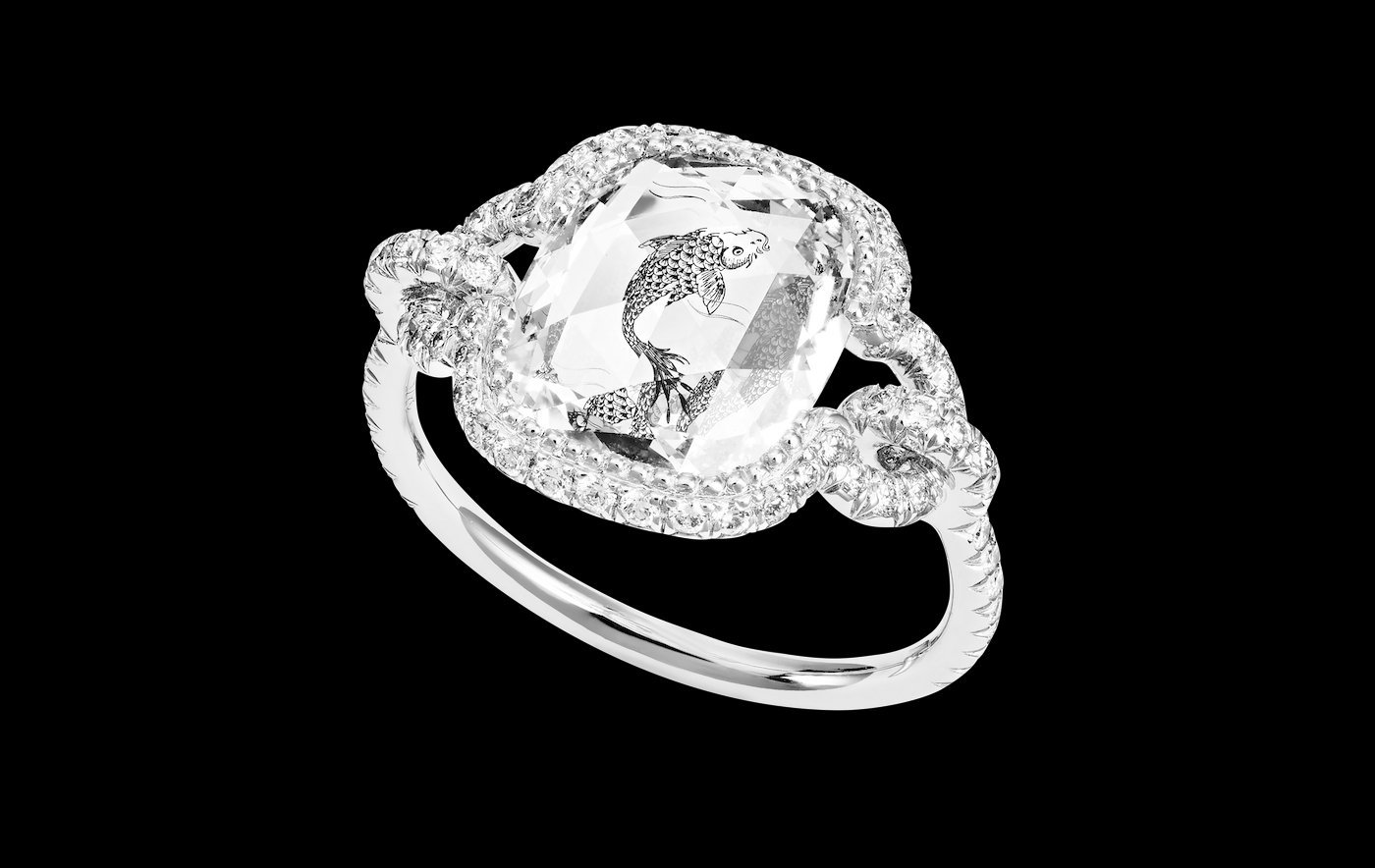
How did you get the idea of tattooing a diamond?
Most inventions happen at the intersection where the need for something, a moment in time and technology come together. The story of the tattooed diamond is a mixture of all these things. First there was a desire: I love tattoos but I hate the idea of having something permanent on me. Secondly, laser technology allows a diamond to be heated very locally, almost imperceptibly. When the carbon from which a diamond is made is burned, the gemstone turns black. A small drawing created by hand is deposited on the surface of the stone, without altering its value. In the 19th century, diamonds were engraved by scratching them with another diamond, but laser tattooing was not an option. Everyone can choose their own tattoo. I usually draw them, but you could also bring me a child’s drawing to be engraved on a diamond for eternity. It would make a great gift for Mother’s Day.
Can these tattoos be removed?
Yes, by re-polishing the diamond.
A piece of jewellery generally appeals to three senses: it can be seen, touched and heard. But you have introduced a fourth sense: smell, with your scented rings. Is this a way of bringing the tradition of the pomander, the scented apple, up to date?
I wanted to introduce the sense of smell into the world of jewellery. So I had to use technology again, even though I always try to hide it. I used 3D printing, which makes it possible to create a three-dimensional object that is in fact built up from layers of material. This means that you can leave a void inside, which is not possible when you cast metal using the lost wax technique, which produces a solid material. In this way, we can create a porous metal object that is impregnated with perfume, like a sponge. The material is only possible because of technology, but I prefer not to talk about that because I want the technology to be at the service of beauty. A perfumed jewel is the stuff of dreams. A 3D printer: no one cares about that. Luxury has never been driven by technology, but by the beauty of an object and the dreams attached to it.
“I want the technology to be at the service of beauty. A perfumed jewel is the stuff of dreams. A 3D printer, no one cares...”
In the 12th century, scented jewellery had a purpose: it was thought that the scent of musk or ambergris protected against the plague, for example. Why add this dimension today?
Because it’s a world I love and we have our own perfume. At some point, I would have liked to become a perfumer. But in no way does my jewellery protect against Covid! (laughs)

You are the last independent jeweller with a boutique on the Place Vendôme. What are the problems you face today as an independent?
There are many of them, every day! You face problems because you are too small, because others block your access, but every situation has its advantages and disadvantages. I often say that my fellow jewellers in the big groups drive buses, and I drive a Ferrari. You have to be careful not to spin off the road, but you can do things that others cannot. But I don’t have the financial resources they have .
I remember a necklace you designed for Louis Vuitton that represented the Champs Elysées seen from above: the diamonds and rubies were like the headlights of cars. It was both geometric and figurative. How did you come up with that idea?
Actually, it was my son Carl who came up with the idea for the necklace. I teach my children to recognise stones, and one evening when we were down on the Champs Elysées, my son, who must have been 6 or 7 years old, said to me: “Look, Dad, there are lots of rubies on one side of the Champs Elysées and on the other side, there are diamonds!” He was looking at the line of cars going up and down.
“I often say that my fellow jewellers in the big groups drive buses, and I drive a Ferrari. You have to be careful not to spin off the road, but you can do things that others cannot.”
Where does your inspiration come from?
From different things: a technique, a beautiful material, something I see, or a flash of inspiration. I often get ideas in the shower. You’re alone there, the phone doesn’t ring. Water is my element; it washes everything else away. I stick to what’s essential.
Since you created of your own jewellery house, customer habits have changed, especially with the emergence of a wealthy and well-informed Chinese clientele, and millennial consumers. What is the current trend, and how are you adapting to these changes in consumption patterns?
Humans haven’t changed: they want good, beautiful and real things, even if they may look at each of these things differently. I’m not a marketing man. I’m a creator, and I will create things I like, not what others like. But I want to be of my time and even a little ahead of it. Today we’re living in difficult times. People need talismans that inspire them and speak to them. This is how the “Metamorphosis” collection was born. We have created pendants too. They’re like shields, granting symbolic protection. We’re also thinking about NFTs. An NFT is not a virtual jewel: it’s a certificate that entitles you to the real thing or to something special that you can sell and give to someone else. Perhaps you might receive the sketches for your own jewellery in NFT format, or the possibility to buy the earrings that go with a necklace or with a ring, under certain conditions. You have to be in tune with the times.
“I often get ideas in the shower. You’re alone there, the phone doesn’t ring. Water is my element; it washes everything away.”
Your boutique even has a secret room. Ultimately, you’re a great dreamer, both chivalrous and a bit of a magician. Was creating jewellery a childhood dream?
I have always loved the idea of jewellery. My parents were diplomats and when my mother put on her jewels, she was no longer my mother: she was a princess. What we’re creating is part of this universe: knights, princesses, women who transform themselves, Cinderella... A piece of jewellery is both a dream and, at the same time, it’s very concrete. It’s not just a fairy tale: it’s also an investment. This mixture of the two is so interesting and fun.
Speaking of which, when you design, in addition to the creative act, do you choose stones based on their investment value?
Not only do I think about it, but it’s essential! If a client buys a piece of jewellery from me, it would be disrespectful not to take the investment dimension into account. Part of my job involves being an advisor: not just aesthetic but also financial. There are materials that I advise on, exactly as if they were for me. A few years ago, for example, I told all my clients to buy spinel, because it is a magnificent stone. Not all of them followed my advice, but in the meantime the prices have exploded! I don’t want to be an investor in gemstones, because otherwise I wouldn’t sell anything, but I do give advice. At the moment I’m inviting my clients to bet on coloured diamonds. Indeed, the price of all natural diamonds has increased considerably.
“When my mother put on her jewels, she was no longer my mother: she was a princess. What we’re creating is part of this universe: knights, princesses, women who transform themselves, Cinderella...”
What would be your ultimate piece of jewellery – or the piece that technically you cannot yet make?
It would be a piece of jewellery that allows you to connect directly to your emotions, without going through the filter of the senses. It would be something poetic and a bit crazy. Why not a jewel coloured with love?

“Gemstones are both a growth and a value investment”
lke Berr is as discreet as she is renowned in the world of jewellery and gemstone brokerage. She has been in the business for decades and developed a passion for gems while still a student in Germany. Thanks to her discretion and patience, she was able to gain access to the prestigious Mogok mine and other mines that are usually closed to foreigners. Most of the stones she buys come directly from the mines, thus eliminating the middleman, which has a positive influence on the price of the stones she trades as a wholesaler.
Elke Berr often collaborates with Anne-Sophie Tourrette, founder of AdvisorOne and co-founder of AWAP, a service community for independent asset managers, who has chosen to work mainly with female clients and defines herself as an “asset stylist”. Over the past few years they have helped private clients with their purchases and advised them on creating a portfolio of precious stones, along the same lines as a share portfolio.
-

- Unheated Burma sapphire 6.00 cts antique stone @Berr & Partners
Europa Star: Why is this a good time to build up a gemstone portfolio?
Elke Berr: Unfortunately, the war in the Ukraine is a hot topic at the moment. If you have to leave overnight, what else can you take with you besides your knowledge and memories? Apart from a few items of clothing and a watch, the only valuables you can take are precious stones. They don’t take up much space and some can be worth the price of a house. In my career I have come across people who have unfortunately had this happen to them, and have been able to start their lives again elsewhere thanks to gemstones and jewellery. Even if, because of the urgency of the situation, they often sold them for less than their full value, these people were able to eat, educate their children and rebuild their lives. It’s a “refuge” asset.
-

- Elke Berr
Let’s look at a case study. Say a client wants to invest 250,000 francs in stones. What would you advise her to do?
EB: Each client is different, so I adapt to her specific situation, preferences and needs. Let’s take diamonds, which are the best known and are easy to mount. What do women wear? Earrings, rings, necklaces. I would advise her to start building a basic diamond portfolio. To start with: two diamonds of the same size and quality, to be mounted as earrings. Here’s a trick you should know: if you have a pair of stones of equal value and quality, their value increases by 5 to 10%. Then I would advise her to buy a 3-carat diamond to make a necklace, and a fourth one of 2.5 carats to make a ring. All diamonds will be engraved and certified by the GIA (Gemological Institute of America) for error-free identification. We will select stones of the same colour and quality, to create a set of four stones that will then be valued. According to Rapaport Diamond Report, this basic portfolio could be worth, for example, CHF 225,000. To this, the client could add a nice sapphire worth CHF 25,000 to complete her portfolio of CHF 250,000, including tax.
“There is a trick to know: if you have two stones of equal value and quality, they are overvalued by 5 to 10%.” Elke Berr
Is this a good time to buy diamonds?
EB: Yes, it’s a good time. They had fallen a lot in the last few years but now they’re continuing to increase in value. Not to mention the increase in the price of rough diamonds due to the war in Ukraine [Ed. note: Alrosa, one of the world’s largest producers of raw diamonds, is Russian and under US and EU sanctions].
If you wanted to invest in coloured stones, which should you buy?
EB: It is essential to ensure that the stone has a certificate from a recognised laboratory. The certificate is the stone’s passport. There are certain conditions that must be met for a gem to be considered an investment stone: it must be unheated, untreated and with a sound provenance. And the larger the stone, the more expensive it is.
-

- Elke Berr in Sri Lanka
What is the disadvantage of a stone portfolio?
EB: You can’t sell them immediately, unlike currencies, for example. They are a safe haven, but over the long term. I would advise keeping them for at least ten years. If you look at the price of some of the quality sapphires, for example, it has risen sharply over the last ten years.
And for someone who’s interested in stones that are less well known than diamonds, sapphires, rubies and emeralds, what’s your advice?
EB: Coloured stones are a bit like blue chip stocks. But you may want to buy some lesser known stones, which are called collectors’ stones. Paraiba spinels and tourmalines are our speciality. Their value has risen sharply since 2010. For example, a 10-carat Paraiba tourmaline from Brazil that was worth $50,000 in 2010 had risen to $200,000 in 2019. All untreated coloured stones, by the way, have risen steadily in value over the past ten years.
“Coloured stones are a bit like blue chip stocks. But you may want to buy some lesser known stones, which are called collectors’ stones. Paraiba spinels and tourmalines are our speciality.”
Do you follow up your clients’ portfolios, a bit like banks that send statements?
EB: Yes, we send out updates on clients’ portfolios based on market developments. During Covid, stones didn’t lose value but they were difficult to sell: no trips were possible, no more fairs, no more exhibitions. And because there was no production, the prices of stones have risen since then.
If a customer needs to sell their stones quickly, do you buy them back?
EB: It depends on the stones, but in general we offer to sell them on their behalf. I make an estimate of their value and, like a broker, I try to sell them at that price, taking a commission of 10% for a coloured stone and 5% for diamonds.
-

- Elke Berr in the Mogok mine, 1987
Who can come to you to build up a portfolio?
EB: For obvious security reasons, a private client must be recommended by an asset manager beforehand, for example.
“A 10-carat Paraiba tourmaline from Brazil that was worth $50,000 in 2010 had risen to $200,000 in 2019. All untreated coloured stones have risen steadily in value over the past ten years.”
Anne-Sophie Tourrette, you advise some of your clients to build up a gemstone portfolio. Why do you do this?
Anne-Sophie Tourrette: Since 2005, Elke Berr and I have been monitoring the figures and comparing stock market investments with investments in stones. We realised that when the stock market is falling, as it is at the moment, the stone market is on the rise. They are inversely correlated, which means that as far as estate planning is concerned, if you have both stocks and stones, not everything is falling at the same time. There is, however, a downside. Stones are not a very liquid market, unlike the stock market, where you can sell your shares immediately and turn them into cash the same day.
-

- Anne-Sophie Tourrette
When one of your clients is interested in a gemstone portfolio, what happens?
AST: It is usually a client who already has some wealth. Investing in gemstones is a way to diversify your portfolio, like buying a painting, and it’s a little-known subject. Genuine investment stones represent only 2 to 3% of the market. If a client is interested, I suggest that she meet Elke Berr. She will explain the different types of stones and show her several gems of different origins and values. Then, if a transaction takes place, the customer will have the choice of having the stone mounted as a piece of jewellery or keeping it in her safe.
“Investing in gemstones serves as a diversification, like buying a painting, and it’s a little-known subject. Genuine investment stones only represent 2 to 3% of the market.” Anne-Sophie Tourrette
What is the minimum investment?
AST: It’s difficult to buy stones with a budget any less than CHF 100,000, because very beautiful rubies of extra-fine quality, for example, can cost more than CHF 70,000 per carat. The larger the client’s assets, the more access they will have to exceptional stones.
What is your role?
AST: I maintain the client’s portfolio. Together with Elke Berr’s team we update the prices of the stones according to the results of the major annual auctions. We draw up a report for the client, explaining the evolution of each of the stones in her portfolio. This is a lot of work: there is no price catalogue for coloured stones, and we use auctions as a reference. Data on the prices of quality stones used in jewellery is supplied each year by the Gemval Institute, but the quality used in jewellery is not the same as that of investment stones. And therefore the prices differ: 97% of stones are used in jewellery and only 2 to 3% are investment stones.
-

- The evolution of the price of sapphire (2005-2022)
The value of exceptional stones has risen exponentially over the years. Do you have any examples?
AST: An unheated Burmese sapphire of 47.07 carats in the most beautiful royal blue colour, mounted on a bracelet, was sold in 1995 for CHF 14,871 per carat. In November 2021 the same bracelet was resold at Sotheby’s for CHF 129,018 per carat. Almost ten times the price! But this is only possible with natural, unheated stones whose size, colour, origin and purity are exceptional.
“Mazal U’Bracha”: two words that make a contract in the gemstone trade
In the gemstone industry, giving your word with a handshake and saying “Mazal U’Bracha” is one of the unwritten rules of trade. And that is enough to cement the exchange, no matter how valuable the stone. “By saying Mazal, you give your word. You don’t need to sign a contract. It’s fantastic! It’s an amazing industry, based on trust,” says Lili Goldberg, the widow of William Goldberg, who was one of the kings of New York’s Diamond District. Indeed, billions of dollars change hands (or change bank accounts) every year, on the basis of this ancient custom . “When you say Mazal U’Bracha, the sale is made,” says Jacob Gueron of Heritage Gems, L.L.C. “You can’t say I’m sorry or go back.”
What does the phrase mean? “In Hebrew, Mazal means ‘good luck’ and Bracha means ‘I give you my blessing.’ The stone has come to you and with all my heart I wish you good luck with it, that you can sell it and I bless you,” explains Rabbi David Leybel, of Leybel-Elieli Diamonds Ltd. However, these two words are not without consequences. If you don’t keep your word, you risk being taken to court, not to mention losing your reputation, which is the lifeblood of this business.

Gearry Suen’s jewellery of the future
n recent years, China has made a name for itself on the jewellery scene. Among those who have led the way are Michelle Wong, Wallace Chan (who made headlines when he first appeared in Paris at the Biennale des Antiquaires in September 2014) and Cindy Chao, whose creations can be found in the collection of the Musée des Arts Décoratifs in Paris.
Some younger designers are following them into the limelight. One standout name is that of 26-year-old Gearry Suen, who in 2019 launched jewellery brand G-Suen in London with co-founder Jing Zhao. While Gearry Suen creates, Zhao does everything else, including looking after the business.
After graduating from Central Saint Martins with a degree in jewellery and design, Gearry Suen went on to complete a master’s degree in jewellery at the Royal College of Art in London. He is one of the up-and-coming jewellery designers who deserves closer attention. At the age of 26 he has already received three awards, including the prestigious Goldsmiths’ Company Award in May 2021 for his ‘Conversation’ earrings.
At the age of 26, Gearry Suen has already received three awards, including the prestigious Goldsmiths’ Company Award in May 2021 for his ‘Conversation’ earrings.

Born in Northern China close to the Russian border, he arrived in the UK at the age of 18. He is part of a multi-cultural generation at ease in a globalised and digitised environment. His jewellery is a bridge between Eastern and Western culture, and between different eras of history. It is the projection of a possible future that relies heavily on the past.
During the last GemGenève jewellery show his creations, all unique pieces, were displayed in the Vivarium, curated by the famous writer and jewellery historian Vivienne Becker.
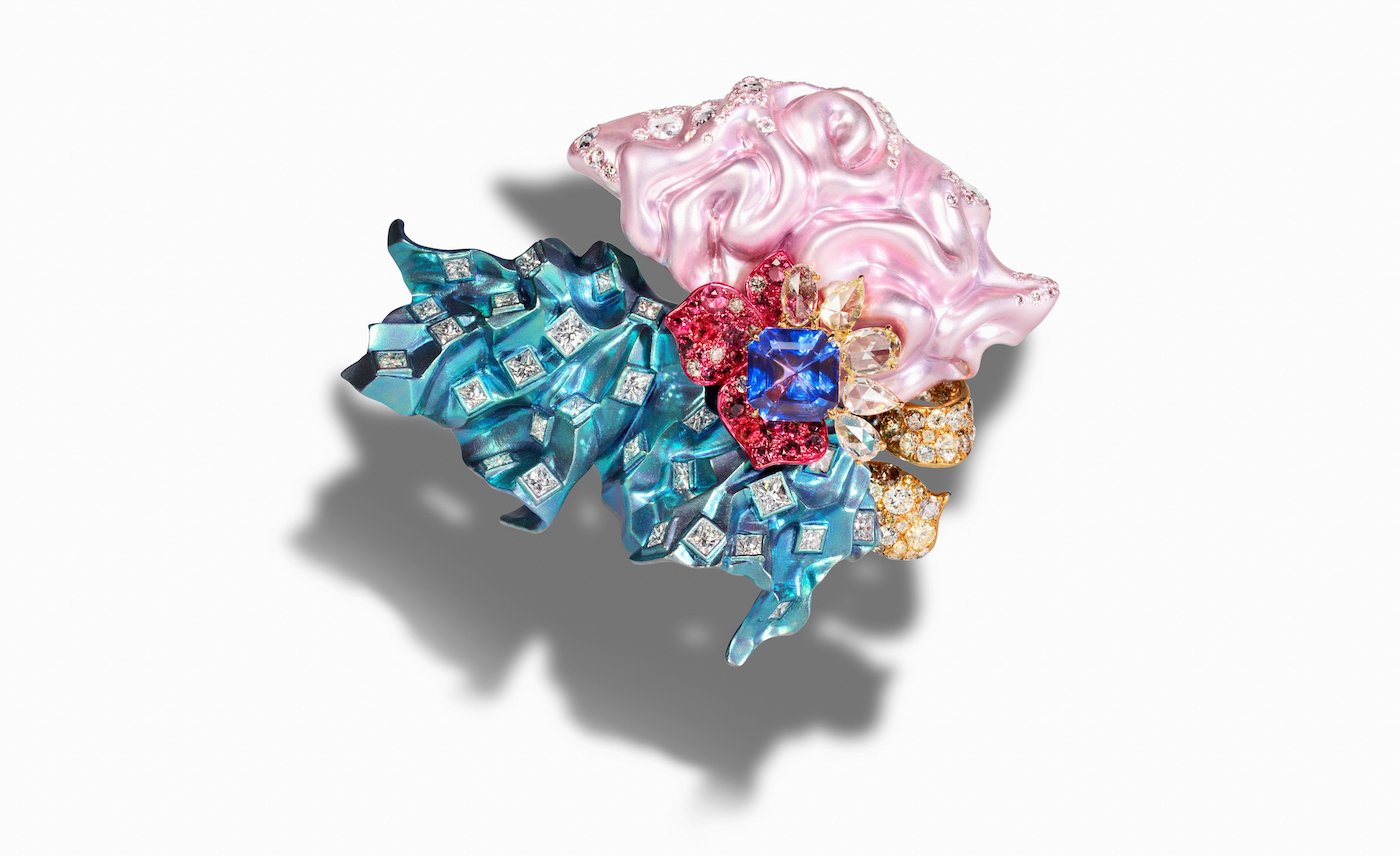
While studying at the Royal College of Art he had access to virtual reality programs, which he learned to use to express himself with complex and surrealist forms, a dreamlike mix of decorative arts and science fiction. But while he uses 21st century tools, he is also familiar with age-old jewellery traditions. He sculpts his pieces himself, in wax, before having them cast in gold, titanium or whatever material best embodies the spirit of the piece.
While he uses 21st century tools, he is also familiar with age-old jewellery traditions. He sculpts his pieces himself, in wax, before having them cast in gold, titanium or whatever material best embodies the spirit of the piece.
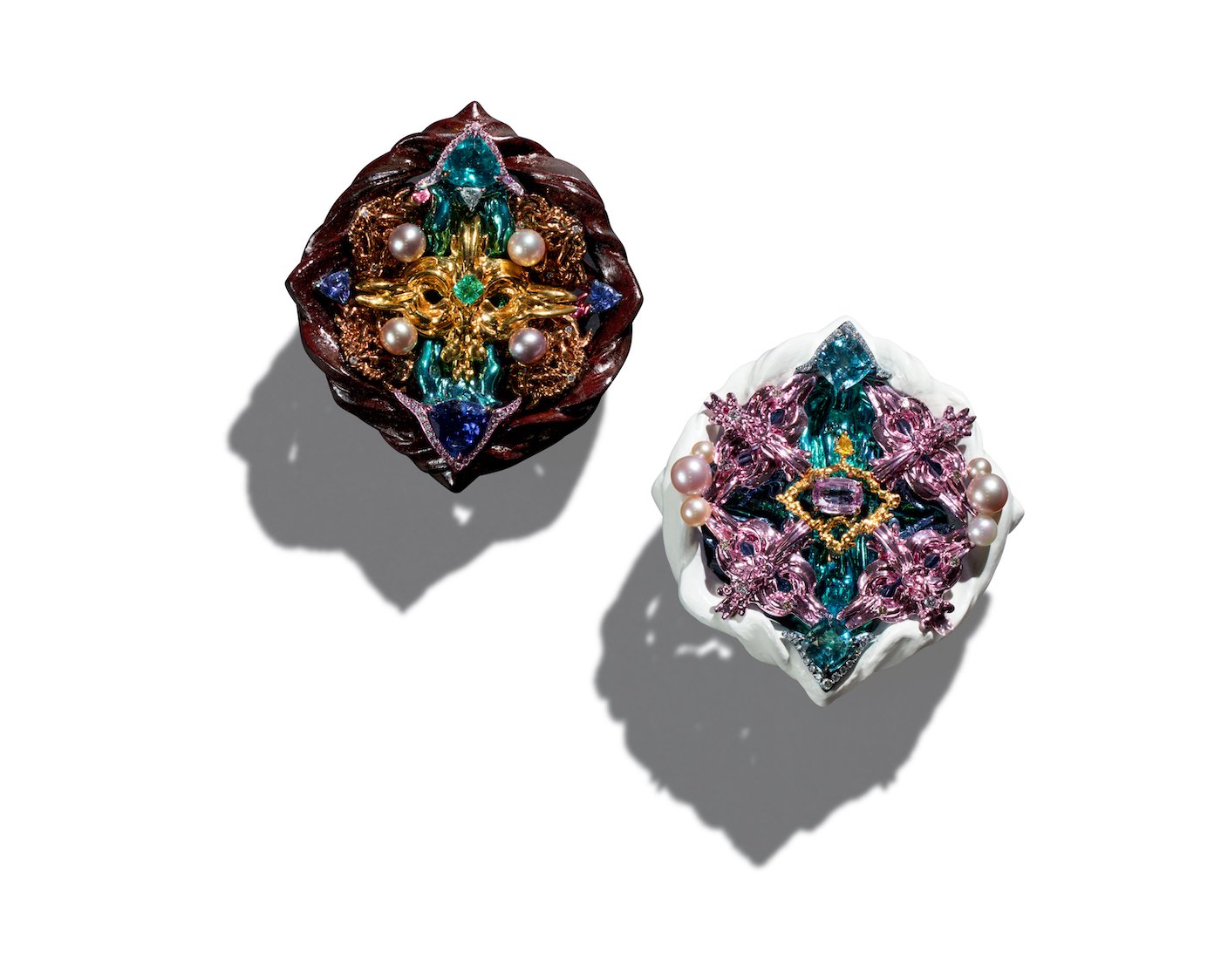
“We live in a digital world, we come from China and we work in the West, we use traditional skills and modern materials, such as titanium or aluminium,” explains Jing Zhao. “With our brand, we connect the past, the present and the future, the digital and the analogue. We are bringing something new to the world of jewellery: powerful, unique pieces that use a mix of traditional and contemporary materials and express our vision of the world. We are young, but we don’t want to abandon tradition for innovation.”
This is why the duo relies on the best artisans, people who master the skills required to make their unique pieces.
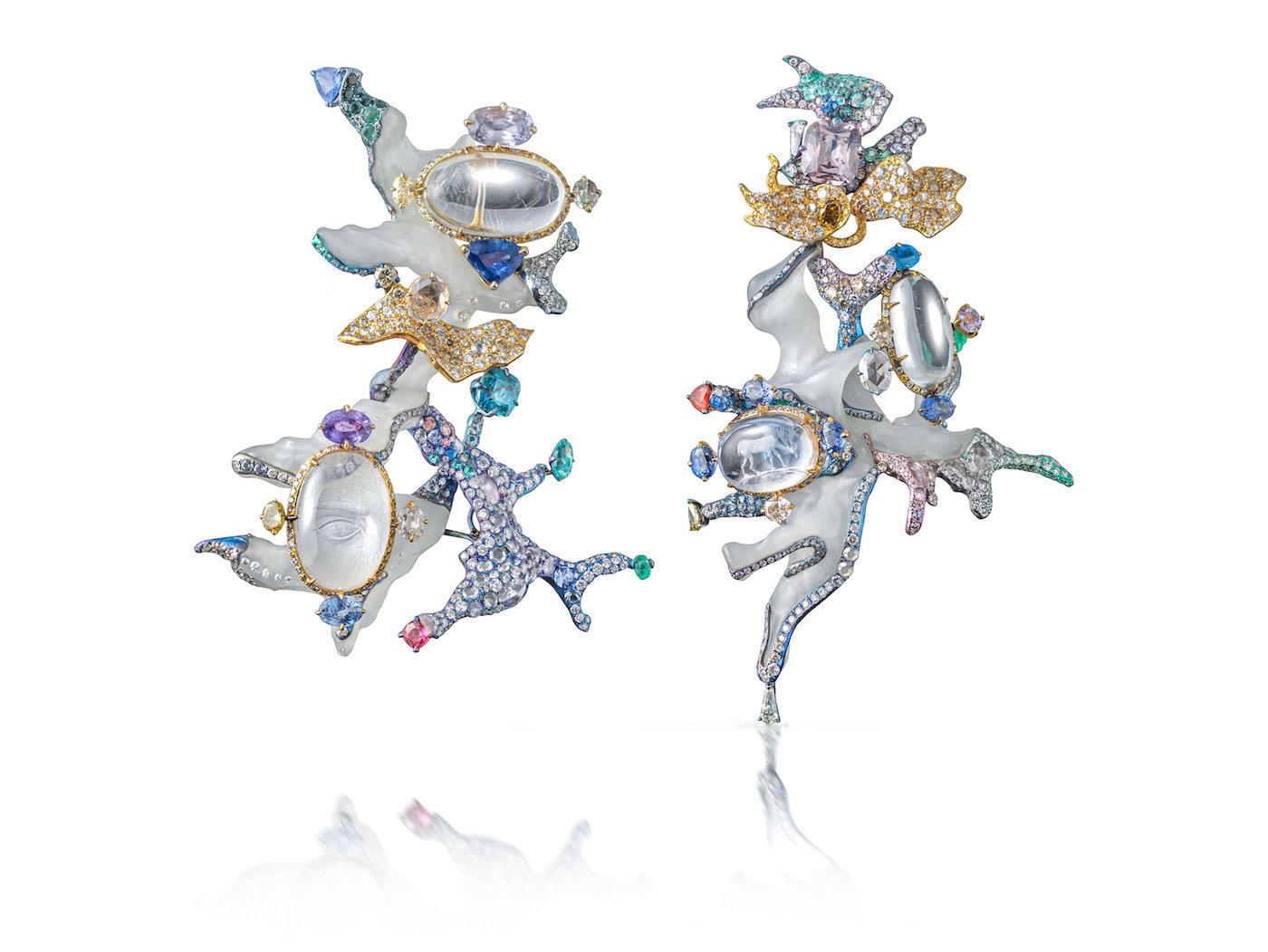
“The creative process is a long one,” explains Jing Zhao. “Gearry starts by making a drawing. Then we ask ourselves what kind of woman would wear this piece of jewellery. We think about the customer from the beginning. We already have a handful of young collectors who buy our pieces. Then we imagine the whole creative process: how much the piece will cost, where it will be produced, who will be able to make it, how long it will take to complete and when we will be able to exhibit it.”
She continues: “Gearry creates the shapes in wax: he is the only one who can transform his 2D drawings into 3D. We found a workshop in London that makes prototypes. We then turn to the best craftsmen. When we need goldsmiths, we look for them in Europe, because that’s where they are, but if we need a jade carver, we turn to China, where the culture of jade carving evolved. The same goes for sandalwood carving. As for titanium, we explore various places in Europe. It is the drawing that guides us to this or that workshop. That is the origin of the whole journey.”
“We are young, but we don’t want to abandon tradition for innovation.”
If you want to gain a better understanding of the brand’s philosophy, you should take a very close look at the Ren earrings in yellow and white oxidised gold, featuring flowers set with custom-cut kite-shaped diamonds. At first glance, they look like the branches of a tree adorned with flowers. But to grasp the deeper meaning, you have to understand the Chinese characters.
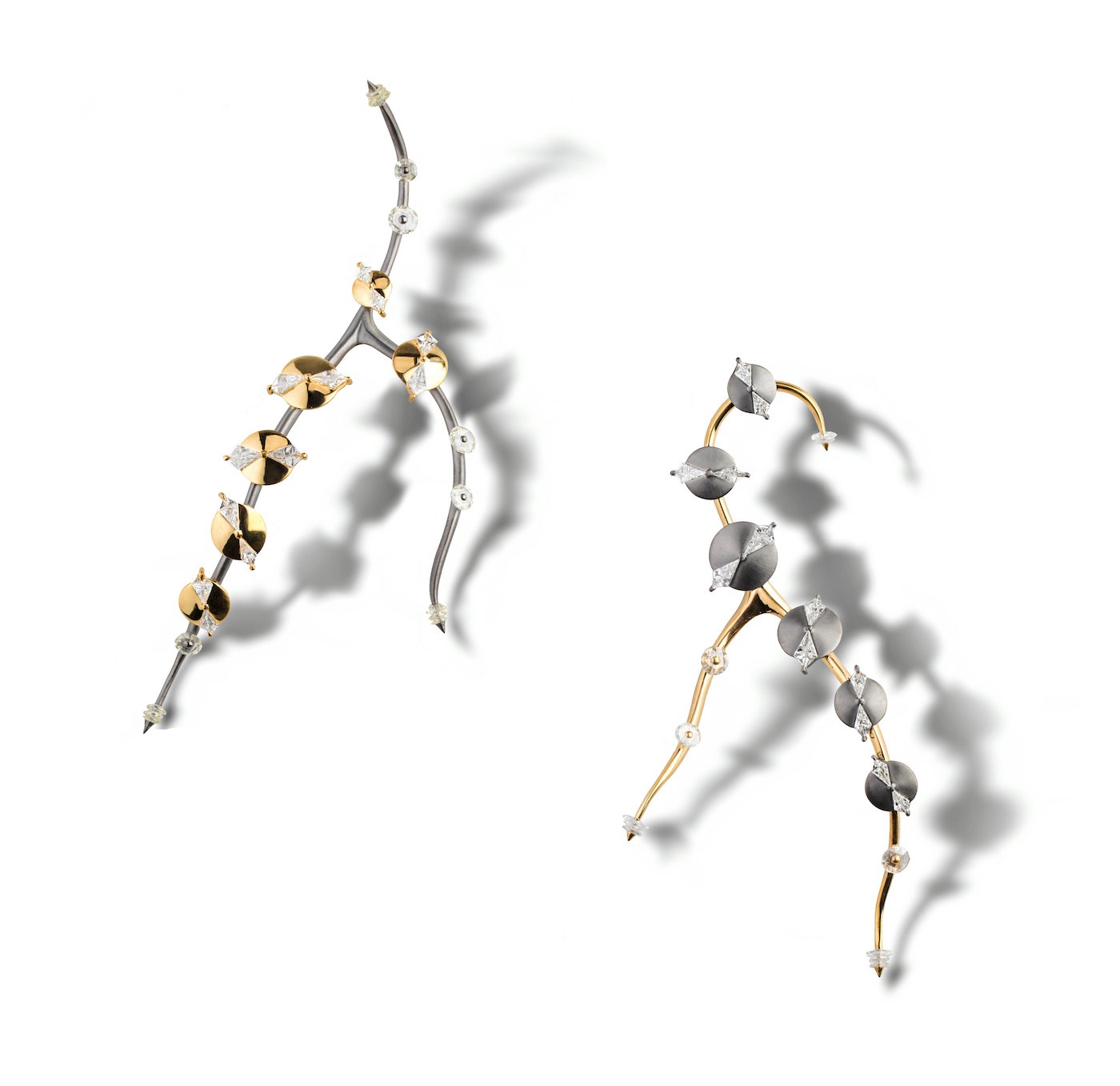
“The left earring is structured according to the sinogram meaning ‘being human’. The right earring is based on the reverse character, which can be interpreted as ‘being elevated’,” Jing Zhao explains. “Representing harmony between humanity and universe, according to Chinese philosophy, these symbols have also been depicted in alien crop circles.”
Where do humans come from? Neither these earrings nor their jeweller can answer this eternal question. But that doesn’t mean the question is not worth asking. Repeatedly.

Epiphanie: jewellery dresses the body and the air
razilian designer Carol Keutenedjian took a few side roads before arriving at jewellery. Born in 1981, she graduated in 2005 with a degree in business administration and quite logically chose to work in the finance and hospitality sectors.
But one day she bought a ring from a goldsmith, who showed her around his workshop. That’s how she discovered the profession: “When I entered this place, although I’m not what you would call a romantic, I literally fell in love with the profession and I told myself that this was what I wanted to do with my life,” she says.
-

- Carol Keutenedjian
With no background in jewellery, Carol Keutenedjian first studied with a goldsmith in Brazil, then moved to Florence to study at the specialised school Le Arti Orafe before taking a further two-year course at the European Design Institute in Milan. When she felt ready, she finally created her own brand in 2009. She named it Epiphanie from the Greek Epiphaneia, which means “appearance”, a word commonly used to describe a sudden intuition or revelation, which is what happened to her.
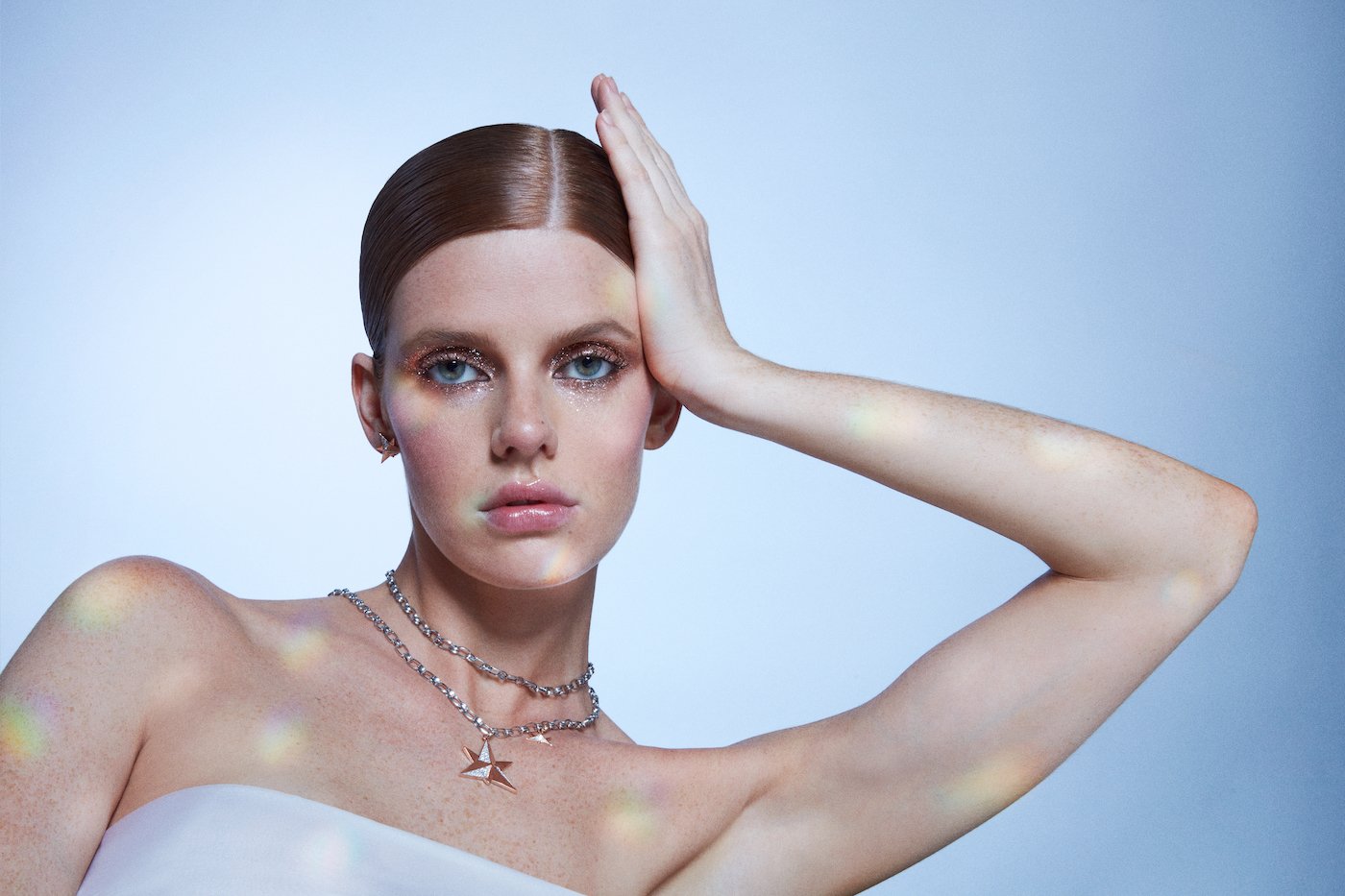
Now based in São Paulo, Carol Keutenedjian creates bridges between jewellery and the body – perhaps as a result of her love for architecture. “My jewellery is wearable architecture. It is light, without ever restricting the movement of the woman who wears it,” she explains. Her creations are ergonomic. Sometimes they take liberties and move away from the body to dress and embellish the air. Her second collection, called Gaia Air, reveals lines of air between the gold: it’s as if the diamonds, emeralds and sapphires are floating.
-

- Inner Collection, architectural jewellery by Carol Keutenedjian
“I’m always thinking about new ways to wear jewellery,” Carol Keutenedjian says. “For example, I have created a very light hand bracelet made of gold chains, ear cuffs and a new phalanx ring, which is worn on the finger joint. We also have a system that prevents it from getting lost, while not taking up too much space in the hand. Our secret lies in the construction and proportions. It all starts with sketches, then we make several models. I try on all the prototypes and wear them for some time before I start manufacturing them.”
Carol Keutenedjian’s jewellery is creative, but that’s not all it is. The jeweller considers it essential to run her business in a fair and sustainable manner. She uses recycled gold and stones from the Fairmined-certified Belmont mine in Brazil. In her eyes, beauty must go hand in hand with ethics.

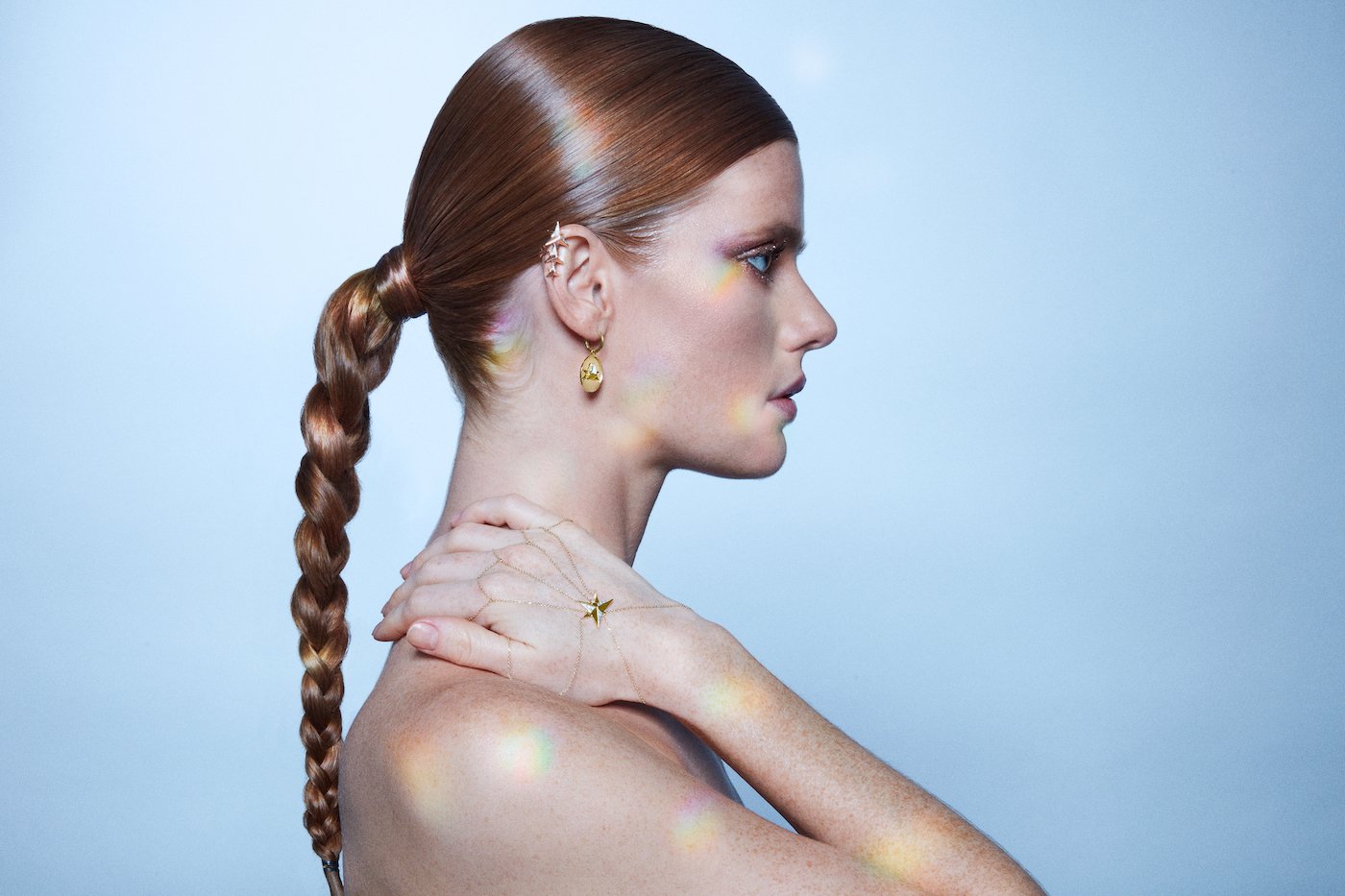

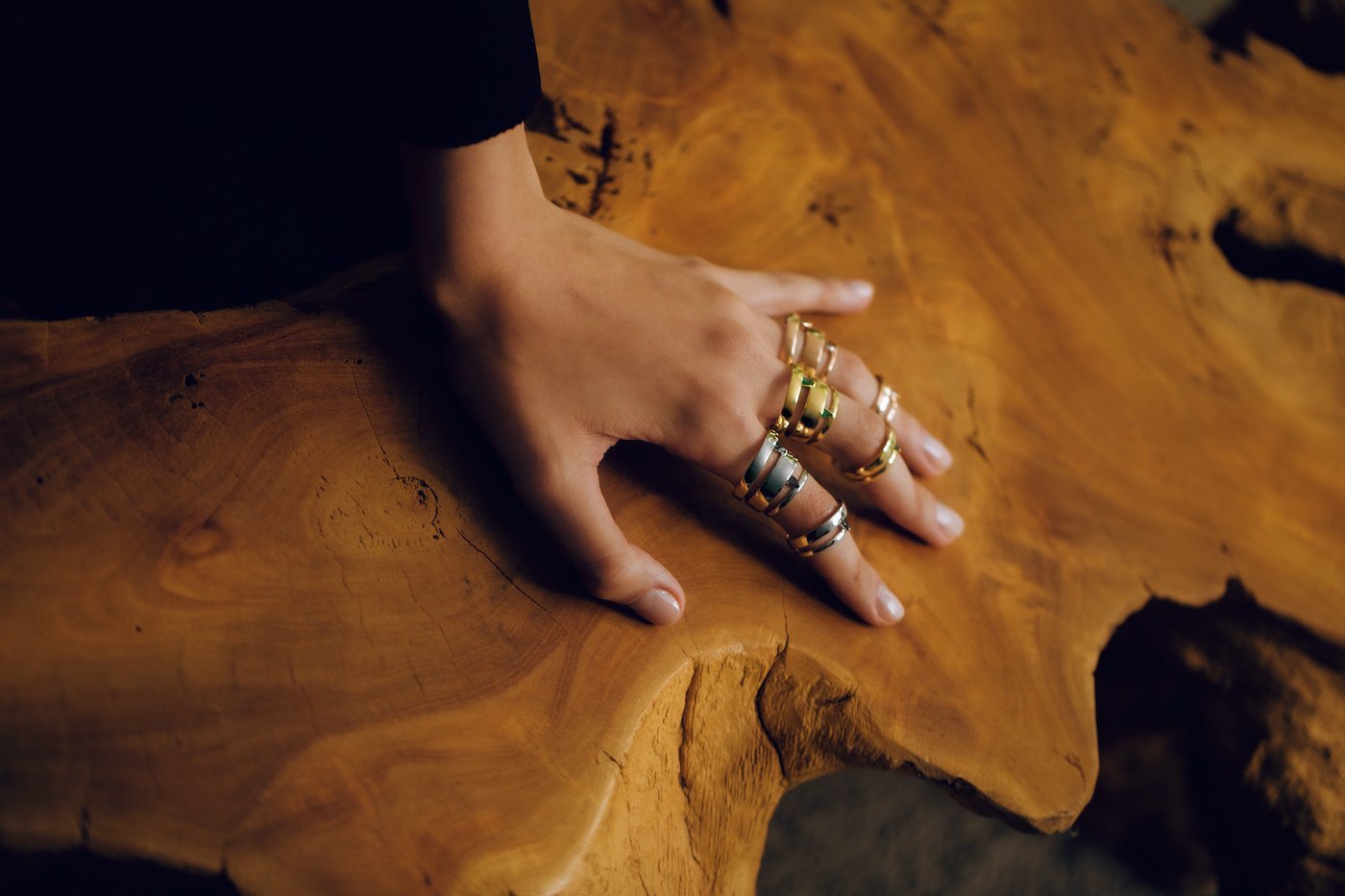
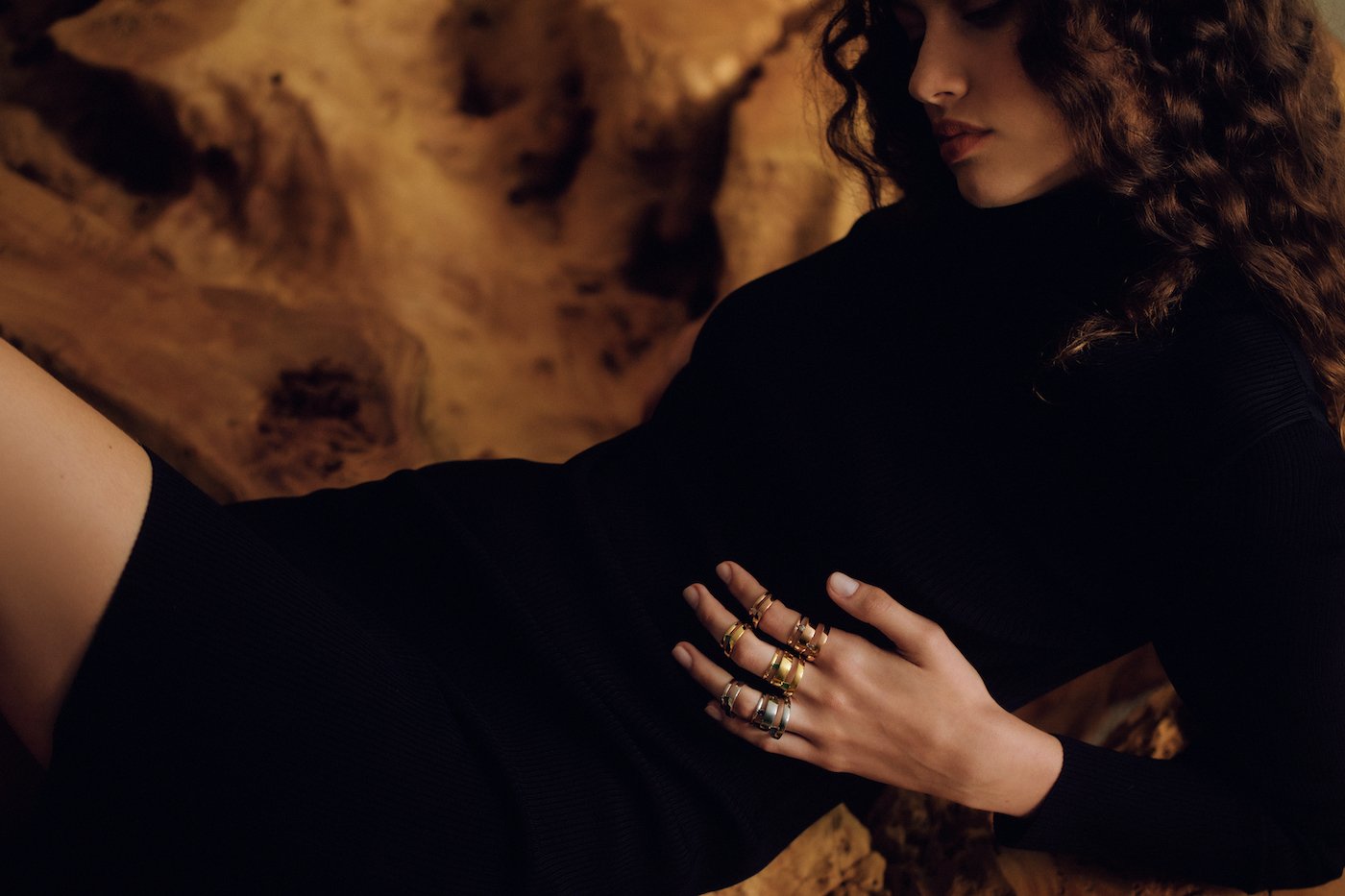

Oktaaf: precious stones, or precious stories?
he approach taken by Oktaaf’s founders is totally new in the field of jewellery. The brand was born on the internet, where the two founders met two years ago during the pandemic. Ainoa Casullas Corres is a Spanish jewellery designer, and Karel de Beule is a Belgian digital entrepreneur.
After being discovered by author and historian Vivienne Becker (read here interview here), the duo exhibited their creations for the first time at GemGenève in April 2022. “Narrative is at the heart of our jewellery,” explains Karel de Beule. “I wanted to create a jewellery brand, I connected with Ainoa and we started to exchange our visions of jewellery. It often comes down to stones and precious metals. We decided to create a brand where, instead of gems, we would use a historical object to tell a story.”
-

- 3000-year-old Egyptian faience beads, given new life in 18K palladium white gold earrings
So they came up with the idea of replacing the traditional centre stone with reproductions of 7,000-year-old Mesopotamian glyph seals, integrating them into the heart of a contemporary ring or pendant. They named this piece “Hashtag” because the seals, created by humans, were used as a signature, to claim ownership of an object. The jewellery becomes both an anthropological object and a symbol of our modernity. And what’s more, it’s stunning. “The final piece must reflect the story we want to tell. I always start with something that has a meaning and a past. From a creative point of view, this limitation is interesting,” explains Ainoa Casullas Corres.
They came up with the idea of replacing the traditional centre stone with reproductions of 7,000-year-old Mesopotamian glyph seals, integrating them into the heart of a contemporary ring or pendant.
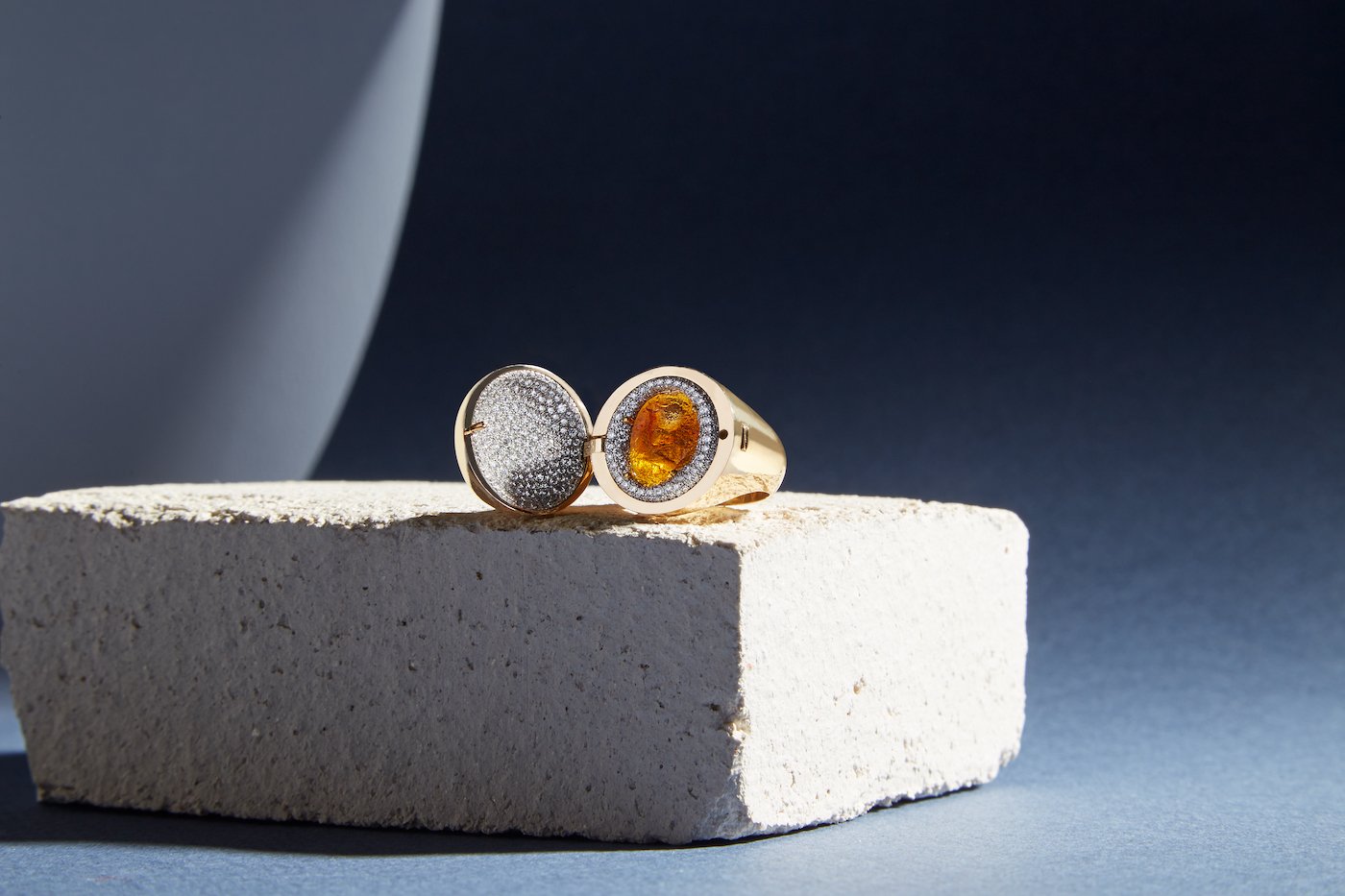
The duo has acquired numerous artefacts, around which they have created jewellery that can incorporate anything from a Roman glass intaglio representing the head of a cherub to the bone of a mammoth, or screws from the Apollo space missions. This approach requires an effort of understanding on the part of the client, or the observer, and the ability to place the piece in a wider context. An Oktaaf jewel is not simply an ornament, even if the talents of Ainoa Casullas Corres make it an object of beauty. These creations encourage reflection on our place in history and in the face of modernity. They are emblems of a timeless – if not eternal – humanity.
One of the most astonishing objects in the entire collection is undoubtedly a pair of cufflinks created with the help of artificial intelligence.
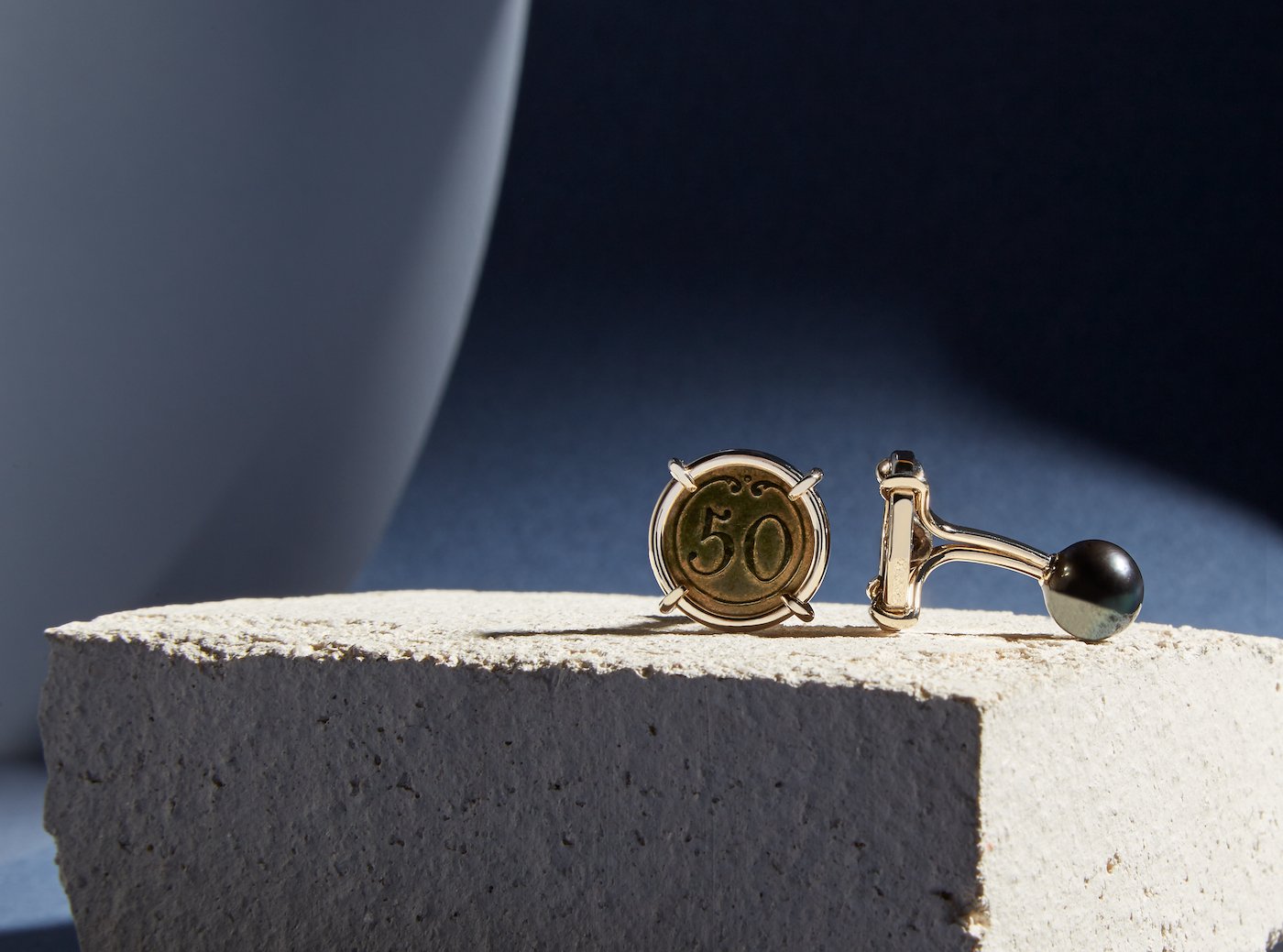
One of the most astonishing objects in the entire collection is undoubtedly a pair of cufflinks created with the help of artificial intelligence. “The titanium screws are from one of Apollo rockets and were made in the 1970s,” explains Karel de Beule. “Of all the objects we bought, they were the most expensive. We wanted to create a piece of jewellery that spoke of the evolution of technology. We had the film 2001: A Space Odyssey in mind. So we called in a Russian artificial intelligence research laboratory and sent them images from the film, the ones that inspired us. We came up with a shape and a final interpretation. This resulted in two pairs of cufflinks: for one, we used mammoth bone attached to the 1970s screws; for the other, we used a block of meteorite reminiscent of the monolith in the film. It took over a year. This is the first time a piece of jewellery has been created by artificial intelligence!” Have precious stones been replaced by precious stories? For Oktaaf, they certainly have.
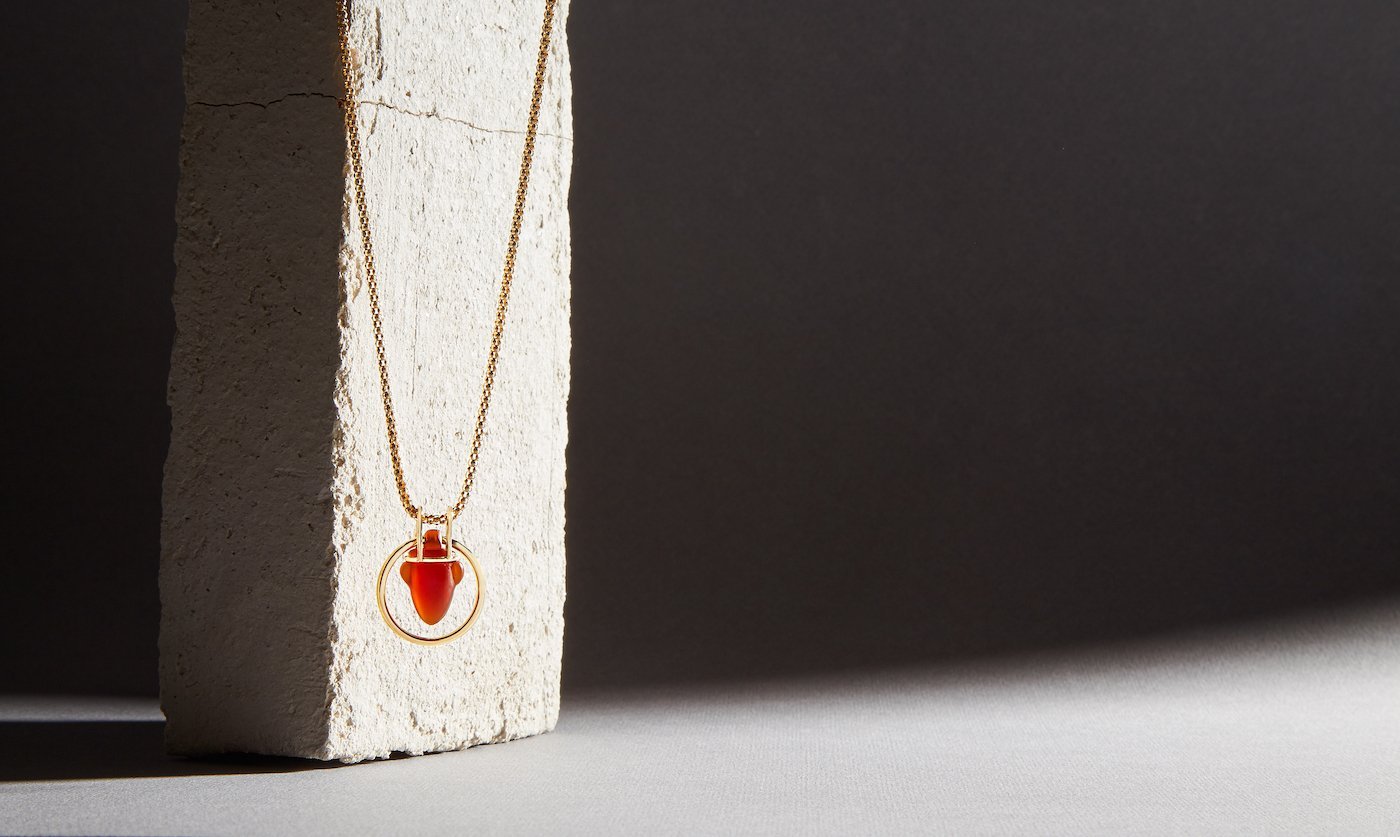
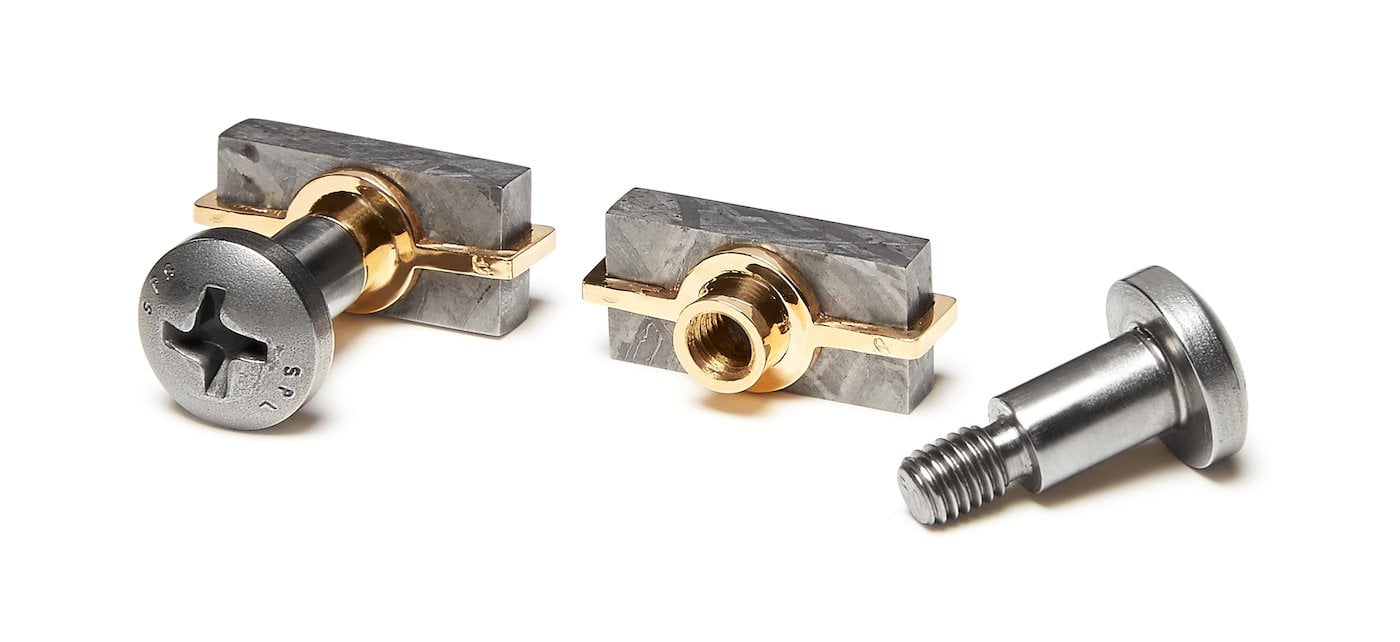
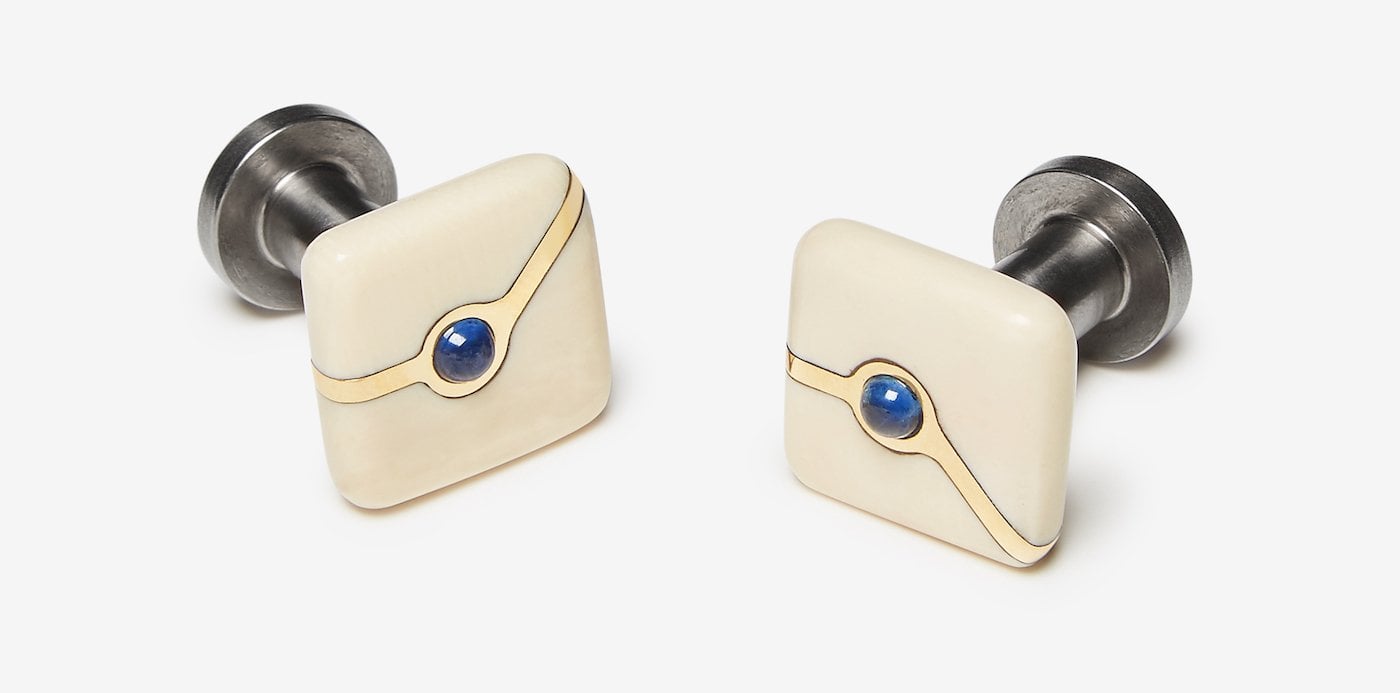
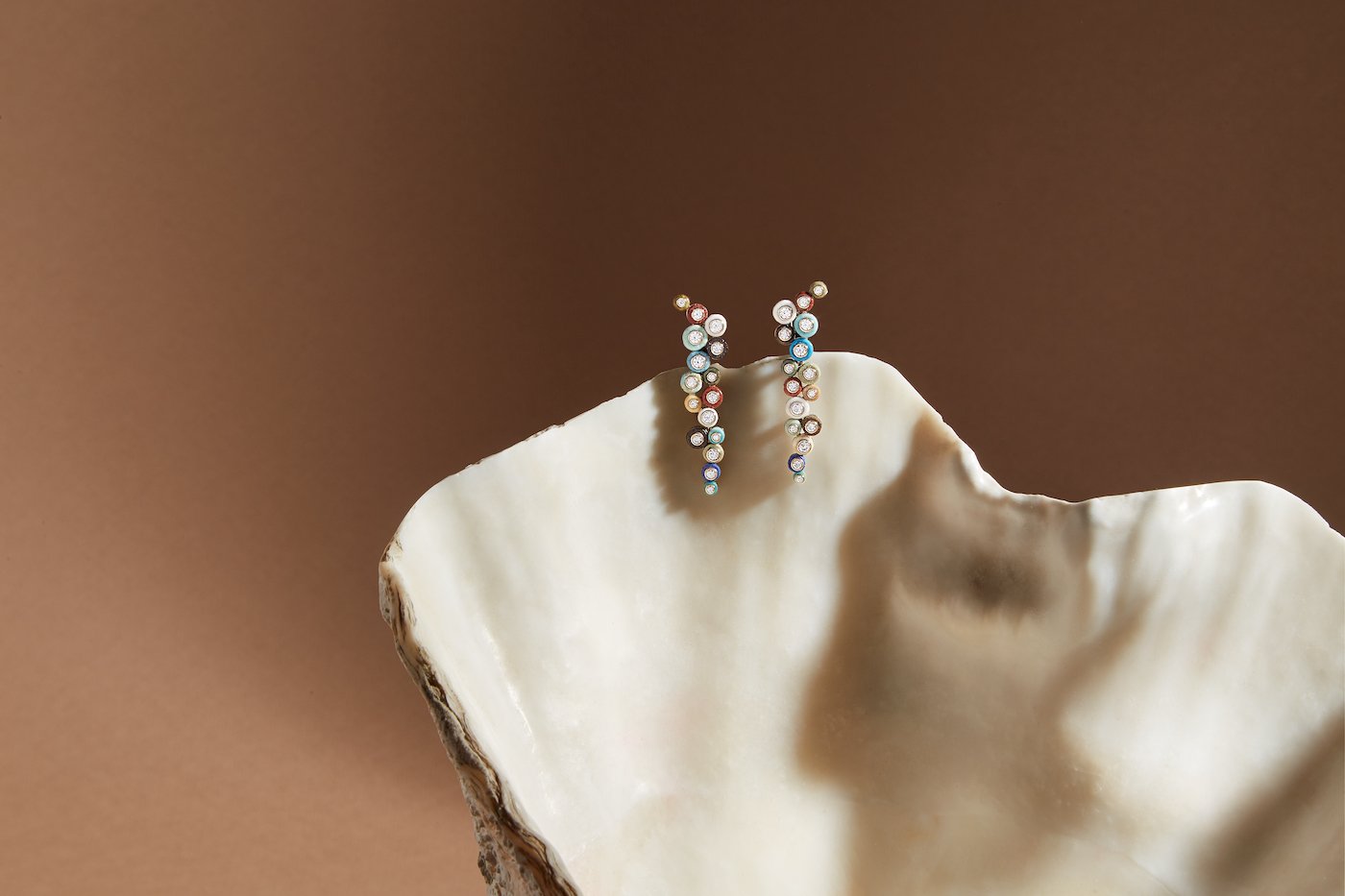
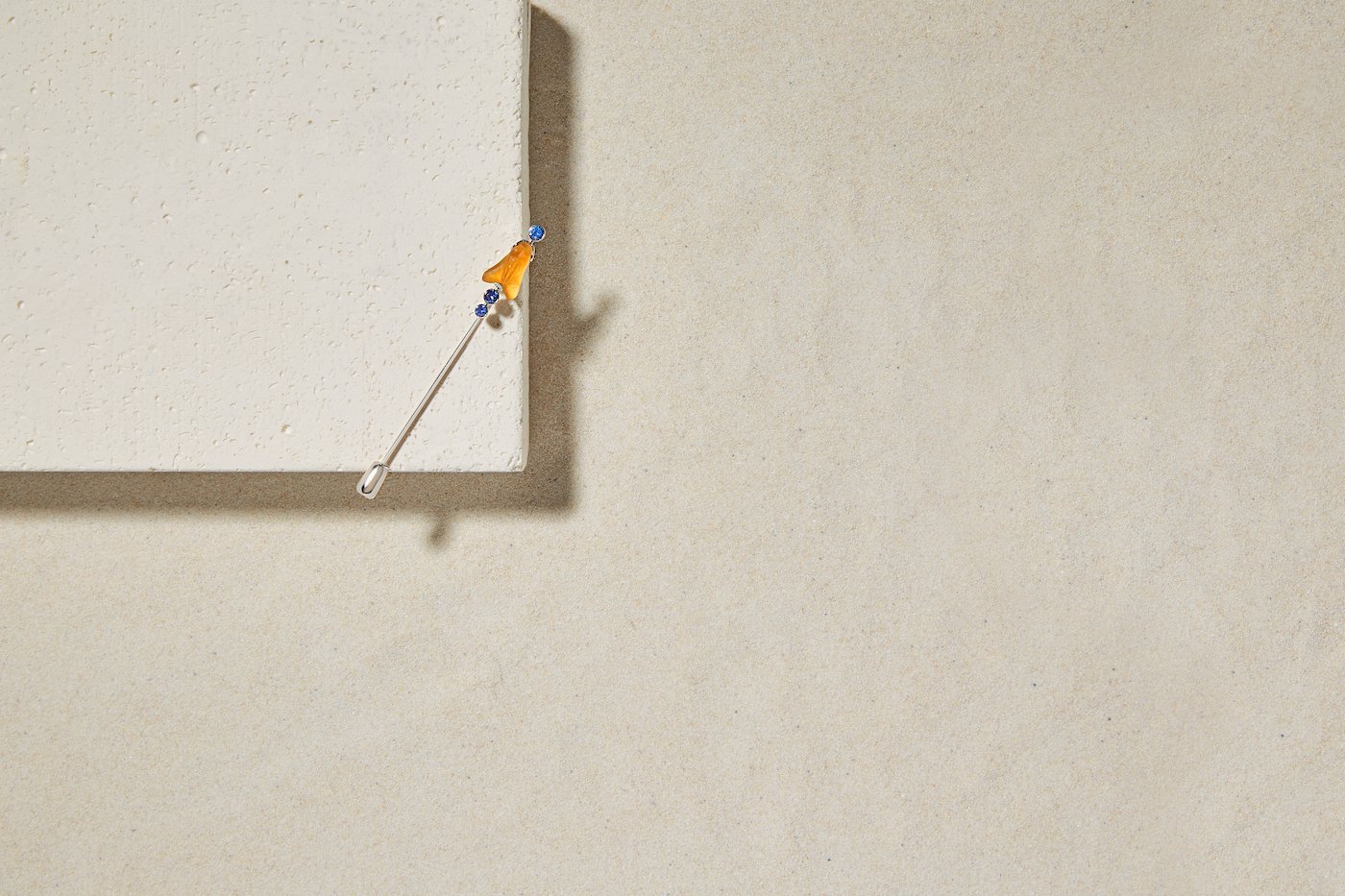
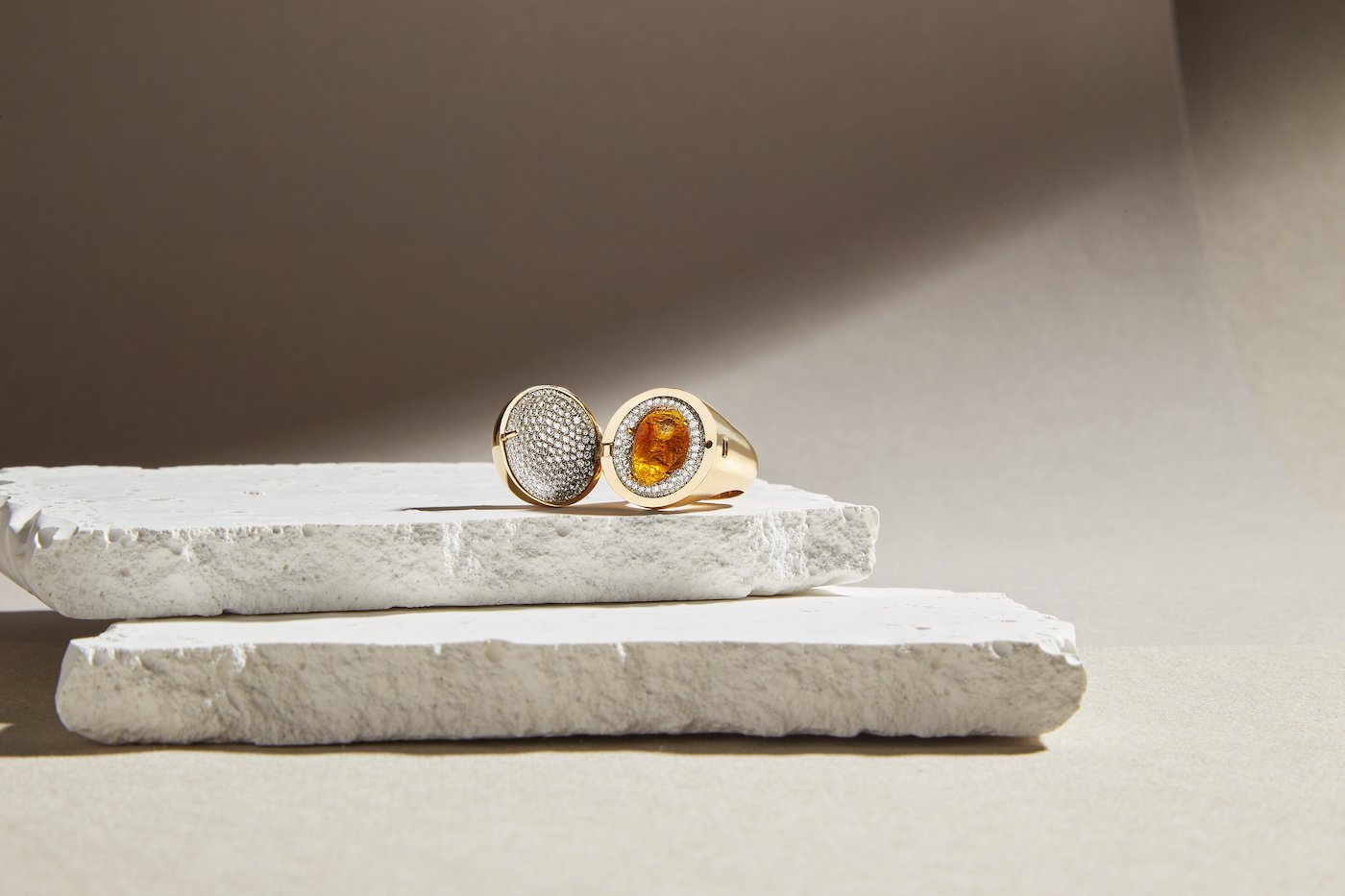

“Nothing is permanent. Why do we expect jewels to be permanent?”
tudio Renn was founded in Mumbai in 2018 by Rahul Jhaveri, 36, a contemporary art collector, and his wife Roshni Jhaveri, 37. The Studio is much more than a jewellery house: it is an art collective whose works take the form of jewellery. The role of these jewels is not merely ornamental: the creations are intended to underpin an idea, a concept. It would perhaps be more accurate to call them “wearable sculptures”.
The couple met at Carnegie Mellon University in Pennsylvania. Before creating their brand, they had no experience in selling jewellery. Roshni, who now heads up sales and marketing for Studio Renn, was a strategy consultant. Rahul, on the other hand, grew up in a diamond family that has been involved in sourcing, cutting and polishing rough diamonds for three generations.
-

- Roshni and Rahul Jhaveri
The brand was born only three years ago and yet, last August, it won the innovation award at the Couture jewellery show in Las Vegas with the “Strangler” ring. This statement piece is made from acid-treated concrete, reinforced with blackened white gold and set with round brilliant-cut diamonds. It is a reflection on impermanence, on jewellery that can also age with time. Renn means “renaissance”. This may not explain everything, but it hints at the importance the duo place on time and its passage in their work.
-

- Studio Renn Transient Ring: a ring made of... concrete!
Studio Renn collaborates with artists, architects, musicians and choreographers. The duo’s creative approach is more akin to contemporary design than traditional jewellery. During the latest GemGenève jewellery fair, in November 2021, the two founders presented their collections. That’s where we met Rahul Jhaveri.
The brand was born only three years ago and yet, last August, it won the innovation award at the Couture jewellery show in Las Vegas with the “Strangler” ring.

Europa Star: Where did you learn the art of jewellery making?
Rahul Jhaveri: I’m not fully trained in jewellery design or manufacture. It’s something I learned out of curiosity. Before I began the studio I worked in the family business, which specialises in sourcing, cutting and polishing rough diamonds. At the same time, I used to design jewellery for friends and family. That’s how I got into the creating side. I learned on the job, without any preconceived notions, pushing things beyond how they would usually be made.
-

- Studio Renn Fish Skeleton Earrings
What was your aim in creating jewellery?
The Studio was born out of a love of design and creation. For us, the creative process is the central point; the jewellery is, in a way, just the physical manifestation of it, one aspect of it. We’re just doing what comes instinctively, and seeing where the creative journey takes us.
“I learned on the job, without preconceived notions, pushing things beyond how they would usually be made.”

What role does jewellery play, in your opinion?
Rather than looking at jewellery as the end of the process, we think of it as part of the process. Every piece sends us in a new creative direction. A jewel is a deeply personal thing, a piece of your identity. That’s how we approach jewellery design. A person who collects our work makes the piece their own; it becomes a part of who they are at that point in time.
-

- Studio Renn Orange Peel Bracelet
You’re not alone in this process: you work with many artists.
Yes, collaboration is a big part of our approach. We work with architects, designers, sculptors, musicians, people from different creative fields who express themselves in their own medium, but there is still common ground because we share a love of creation. For instance, when we worked with contemporary artist Prashant Salvi, we didn’t interpret his work: he was part of the creative process. He created a series of sketches from our discussions, and we created jewellery. It’s not really a collaboration, it’s more a conversation that we are having with other creative people. It’s from that kind of dialogue that many ideas and a huge amount of energy are generated.
“Nothing is permanent. Why do we expect jewellery to be permanent?”

You made a ring out of concrete. Where did that idea come from?
It came from absolute stubbornness. It took a year to conceptualise it. It was a work that was commissioned by an architect, a collector of ours, who wanted to wear a solitaire ring that felt powerful and strong. I proposed creating one out of concrete because, even though it feels like it’s permanent, it’s not. Concrete has a life span of only 20 or 30 years. That’s why the piece is called the “Transient Ring”, because it’s going to fall apart. But that’s the beauty of the piece! It’s gonna age, it’s gonna change, much like our cities. We expect our cities to last forever but there are not designed to. They change constantly. To make the ring we collaborated with another firm of architects (Material Immaterial Studio, in Mumbai) to figure out the mechanisms and how to make the ring in concrete. And when it was completed, we treated the ring with acid to partially destroy it.
-

- Studio Renn Strangler Ring
This collector has to be around in 30 years, when the ring falls apart, in order to recover the diamond!
The diamond won’t fall off because the ring is reinforced with gold. It’s a strong piece: it will last, but it will age. This is the kind of philosophical process we go through at the Studio. Everything we create is meaningful, purposeful. Everything tends to be more than it seems.
We tend to think that jewellery lasts forever, and can be passed from one generation to the other.
Nothing is permanent. Why do we expect jewels to be permanent?

Debusigne: a bridge between two worlds
line Debusigne expresses herself in a soft voice: she would gladly let her jewels speak for her if they could. Actually, looking at them, you can tell a lot about her love for old diamonds, antique jewellery and creations that go beyond simple ornamentation. The Basel-based jeweller studied ancient history and philology before deciding to make jewellery her profession, launching her own brand, Debusigne, in 2018.
Her designs are contemporary, but with a discreet nod to Antiquity: they oscillate subtly between past and present. “Antique jewellery has always been part of my life,” she says. “My taste lies somewhere between the end of the 19th century and the beginning of Art Deco, when more contemporary geometric lines began to be explored.” It is hardly surprising to learn that her Danish-born mother wore late-19th-century sleeper earrings and 1930s rings given to her by her father. It’s a kind of atavism.
Aline Debusigne expresses herself in a soft voice: she would gladly let her jewels speak for her if they could.
-

- Pair of Debusigne earrings set with rose cut diamonds
She designs all her own creations, which are then handmade by others in highly specialised workshops in Geneva and Paris. “I chose them because they have experience with antique jewellery,” Aline Debusigne explains. She has a particular taste for old-cut diamonds, which have fewer facets than modern cuts and are often neglected by other professionals. In the beginning, she bought old brooches and dismantled them to recover the stones. But only 10% of them lived up to her expectations, so she turned to specialist suppliers.
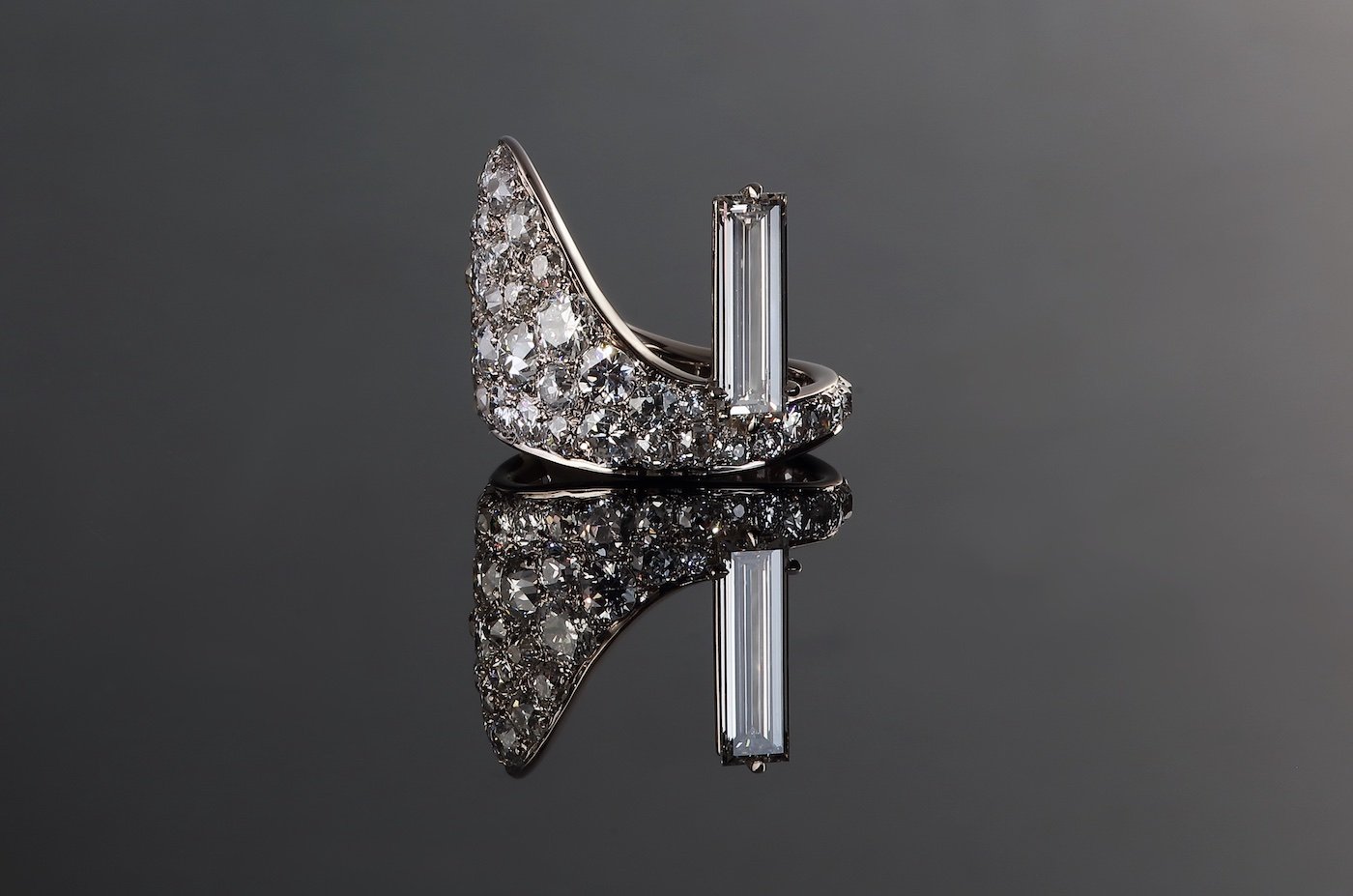
The designer likes to let the stones express their own “fire” within a setting that doesn’t steal all the light. This probably explains why she likes the natural appearance of white gold, without rhodium plating, which leaves the diamonds to shine. “Depending on the light, the metal changes colour and takes on warmer hues.”
The designer has a particular taste for old-cut diamonds, which have fewer facets than modern cuts and are often neglected by other professionals.
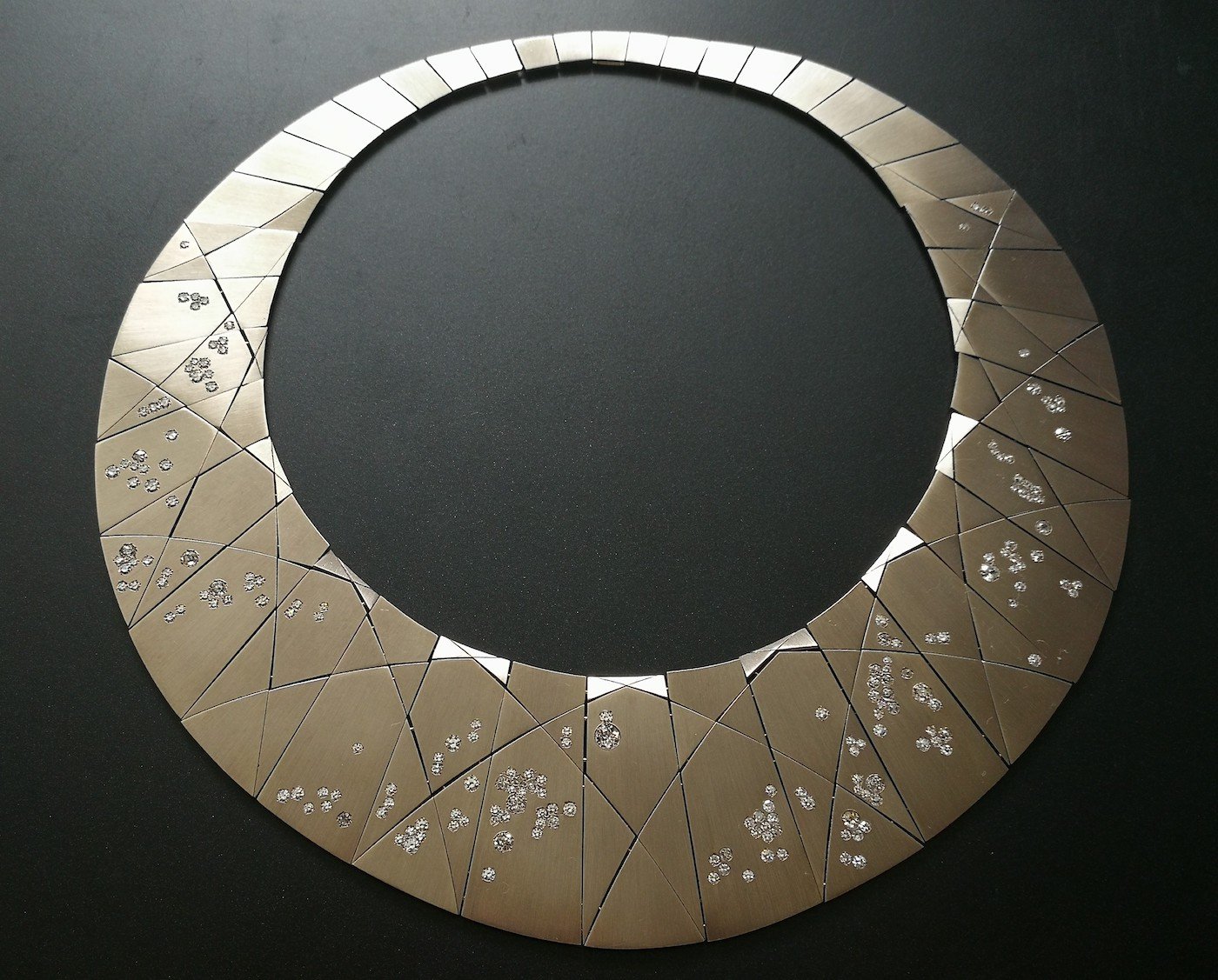
Her plastron necklace, for example, is a marvel of architecture: it sits like an Egyptian pectoral on the chest and, because it is fully articulated, moves with the wearer’s body. It is almost invisibly set with brilliant-cut diamonds that look as if they have been thrown haphazardly onto the piece (in fact, they were meticulously placed), creating the effect of a scattering of stars. The creation is like a precious piece of armour. Another jewel, a ring that resembles a mini-tiara with a brown diamond, was inspired by the shuttles in the latest Star Wars film. With Debusigne, past, present and future are intertwined.
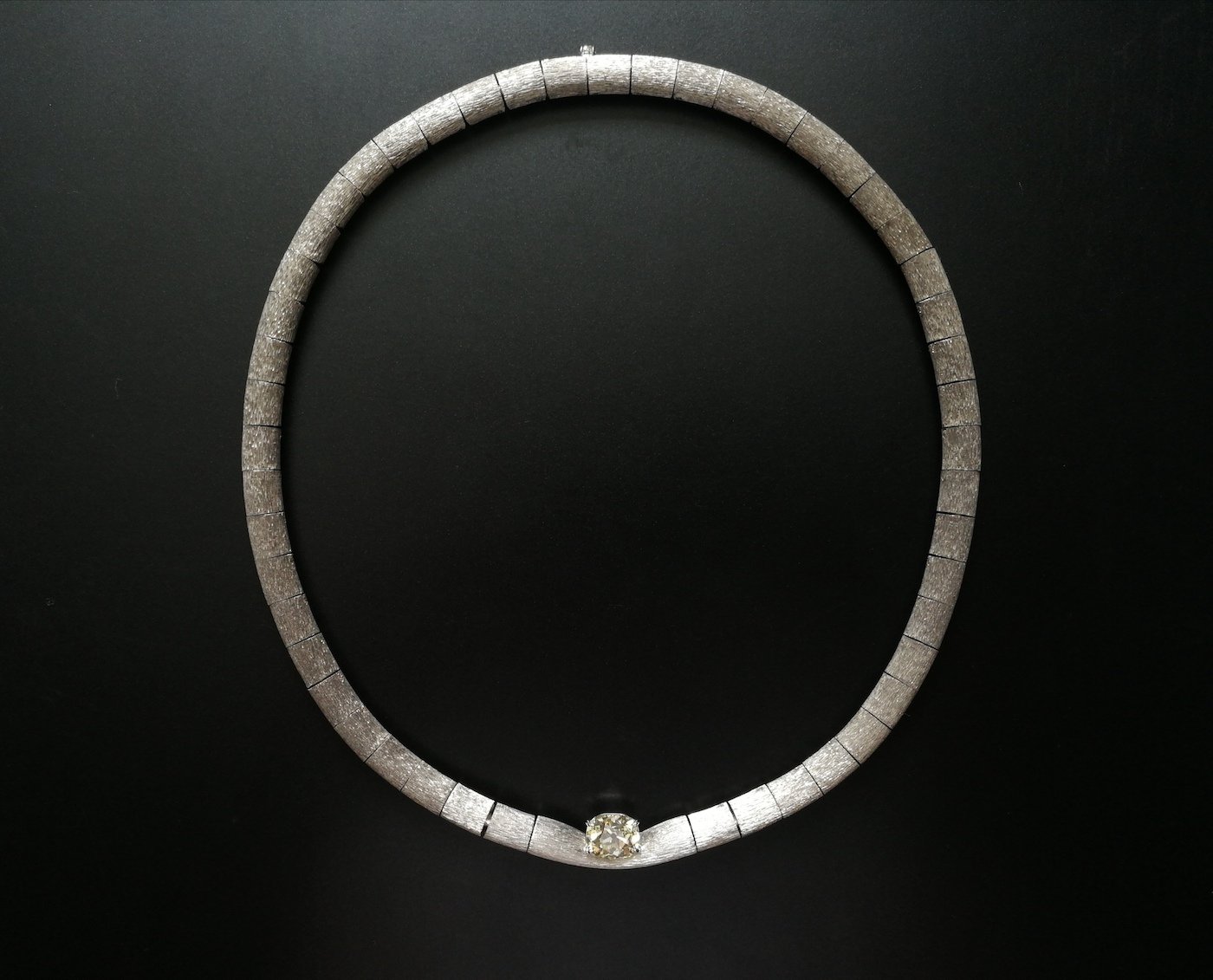

Maria João Bahia, the magician of Lisbon
alking down Avenida da Libertad in Lisbon, you suddenly come across a four-storey “Pombalino” building with an amaranth-red façade. It’s intriguing and inviting. As you lean towards its windows you discover treasures: jewellery like organic sculptures, marrying precious materials – gold, diamonds, rubies, sapphires – with others that are less rare, such as mother-of-pearl, wood and semi-precious stones.
They are all signed by Maria João Bahia. For the past thirty years, this jeweller has been creating talismans, urban elf ornaments, trophies, medals and enchanting pieces for the table.
-

- The boutique of Maria João Bahia in a Palombino building in Lisbon
Her musician grandfather and sculptor father gave her a taste for beauty. She had a hard time deciding between law and goldsmithing (which would seem to have little in common), but creativity won out over judicial rigour and, in 1985, she set up her first workshop in Lisbon. Maria João Bahia opened her unusual sunset-coloured boutique in 2004, and that was where we met.
For the past thirty years, the jeweller has been creating talismans, urban elf ornaments, trophies, medals and enchanting pieces for the table.
-

- Maria João Bahia
Europa Star: You studied law. What finally led you to jewellery?
Maria João Bahia: I studied law because that’s what all my friends had chosen. My university years were fun: we partied a lot. I really liked international law and goldsmithing, and studied both at the same time, while learning drawing at the Fine Arts School. But after three years, things got more serious at university and I left. I was born into an artistic environment: my father is a sculptor and I grew up surrounded by art, sculpture and painting. It was part of my normality. I remember one day – I must have been five years old – as my father was finishing a monumental sculpture in his studio, he invited me to sign it too, telling me that no one would know. Those were unforgettable moments...
-

- Attitude Collection: Trilogy pin, red and white coral, pearl, diamond, topaz, 19.25K yellow gold
Was jewellery a childhood dream of yours?
Yes. When I was twelve years old, I used to make jewellery and belts with stones, beads, shells and rope... I did this in a very natural way and sold them in the shops beneath my parents’ house. My mother’s friends used to buy them. I don’t remember keeping any.
Did you have a mentor?
My first mentor was my father, but I wasn’t aware of it at the time. When I decided to create jewellery, I went to learn the trade in a workshop in the north of Portugal. There I learned to design my own tools with a master jeweller called Manuel Alcino. He taught me goldsmithing. It’s a craft that involves many secrets normally passed on within the same family. But he agreed to teach me. Then I went to a jewellery workshop in Lisbon, where the work was more precise, using smaller dimensions. I wanted to learn the know-how so that I could develop it according to the designs and ideas I had in my head. If you just apply the established rules, you create soulless jewellery.
“If you just apply the established rules, you create soulless jewellery.”
You also design tableware, cutlery and bags. Is it because you want to inject beauty into everyday activities?
I started designing certain pieces because I needed them and I couldn’t find them on the market. For instance, before the revolution, my family used silverware in our daily lives. But then everything changed. I asked my mother why we didn’t use silver cutlery for dinner any more. She said that it was difficult to clean. Years went by and I looked for a solution. I created a silverware set that can be machine washed and used every day. My secret? I had them hammered, so you can’t see the flaws. They are always impeccable.
Your creations are organic. What are your sources of inspiration?
Portuguese nature and architecture. For example, I think our pavements are beautiful, with those black and white cobblestone designs. I have created many collections inspired by them. I also like the wrought iron work. We are lucky to have the most beautiful light in the world in Lisbon. I don’t know if it’s because of the white of the pavements and the blue of the ocean, but it gives a very special luminosity.
“We are lucky to have the most beautiful light in the world in Lisbon. I don’t know if it’s because of the white of the pavements and the blue of the ocean, but it gives a very special luminosity.”
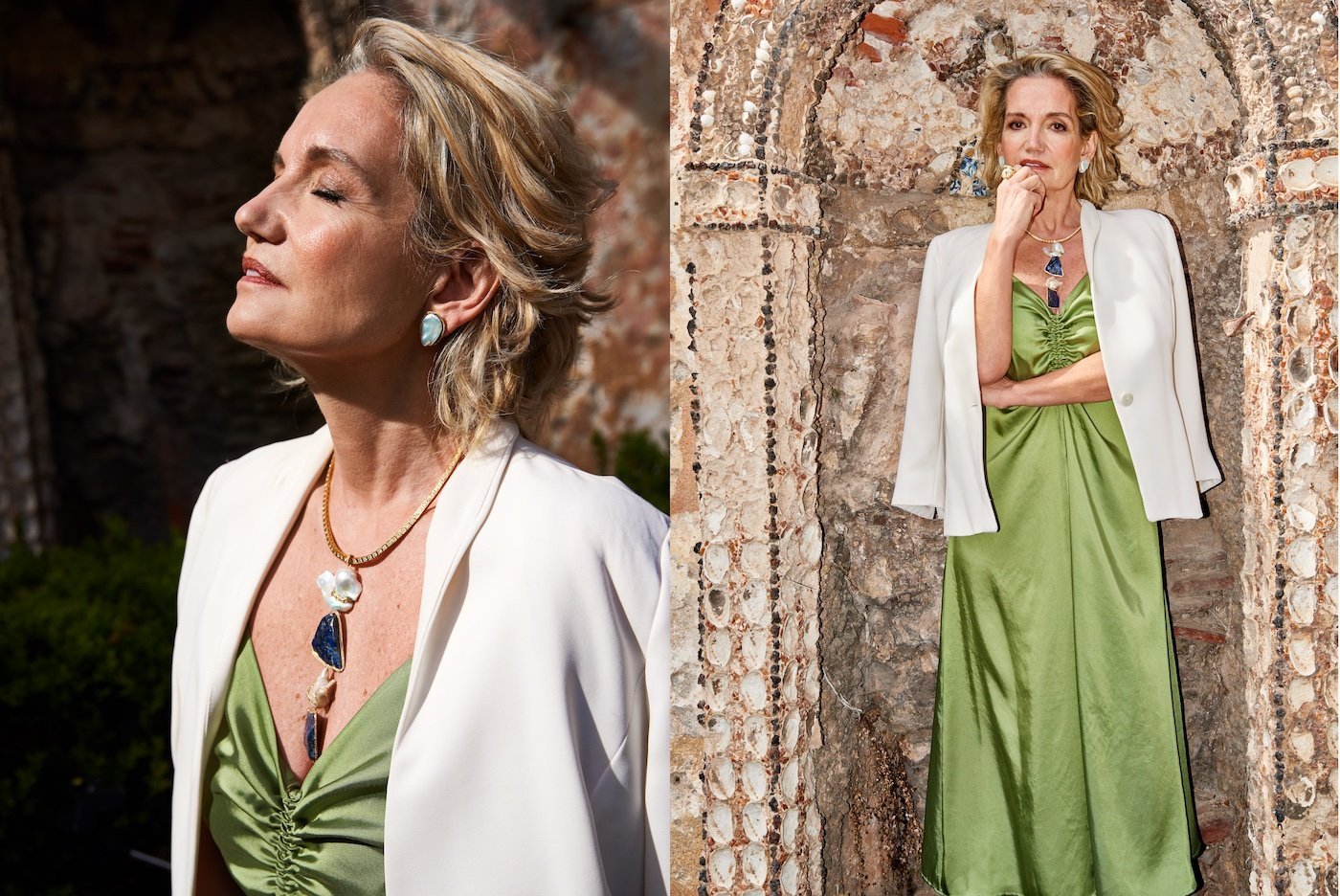
For some of the jewellery, you use the typically Portuguese technique of filigree. Is it a way of keeping an ancestral craft alive?
We use the ancient technique of filigree, but in a different way. This famous gold work, in which two wires no thicker than a hair are twisted and used to create patterns, dates back to the Phoenicians. I have simplified it in order to obtain a more airy, refined effect.
Is it difficult to find craftspeople who can use this technique?
No. What is difficult is finding people who know how to put soul into what they do.
You have set up your boutique and workshops in a typical “Pombalino” building. What is its history?
In 1755, there was a terrible earthquake in Lisbon and part of the city collapsed. The Marquis of Pombal had some areas and the city centre rebuilt. He gave his name to an architectural style; the Pombalino style. But I don’t know the history of this specific building.
Your jewellery almost feels as if it’s alive – it’s more than just decoration. Do you believe that a piece of jewellery can have magical powers?
Yes, I am convinced of it. For many years I wondered why people bought my jewellery, because they didn’t need it: you can live without it. Clients sent me letters, gifts, bouquets, but I didn’t understand why. I had simply done my job. Until one day, one of my clients, who held a very important position in the government, confided to me that before an important meeting she would come to my house to buy a piece of jewellery. She was looking for a special piece to dominate the meeting. It was an object of power for her. I realised that she was not the only one. One of my clients was desperate to get one of her necklaces repaired, to take to an important medical appointment: she told me it gave her strength. Most women buy jewellery for a special occasion. This gives meaning to my work.
Your pieces draw us into a world of wonder. Do you feel like you’re a bit of a magician?
Thank you! If I am, it’s totally unconscious. I need to feel the object: I need to establish an almost alchemical relationship with my jewellery. They are not anchored in an era, they don’t follow fashions: they are of all times, all at once.
“I need to establish an almost alchemical relationship with my jewellery. They are not anchored in an era, they don’t follow fashions: they are of all times, all at once.”

Gi by Giselle Effting: the highlighted body
efore designing jewellery, Giselle Effting was a model. She started her career at the age of 15 and soon caught the eye of fashion designers and jewellers. For ten years she travelled the world, living wherever her contracts took her – until she discovered her true vocation: jewellery. The young woman then followed the classic curriculum of those who want to enter the profession fully, studying at the Gemological Institute of America (GIA). Immediately after graduating, she went to work with a friend, a gem trader, but she quickly realised that her interest lay not in sales, but creation.
-

- Endo earhook and Trapez handpiece made in titanium set with diamonds
In 2014 she was hired by a major jeweller in Hong Kong, King Fook Holdings, specialising in pure gold jewellery and gemstones. “My bosses were genuine mentors: first Howard Yeung, who hired me, and then his brother Kin Yeung, who taught me Chinese philosophy,” she points out. “They hired me to develop a collection of pure gold jewellery, inspired by Chinese culture but seen through my foreign eye.” Because she wanted to learn how to create a piece of jewellery from scratch, Giselle Effting enrolled at the Alchimia Contemporary Jewellery School in Florence, where she obtained a degree in fine arts with a specialisation in jewellery. After that, she could let her imagination run wild.
Europa Star: How did you come to create your own jewellery brand in 2019?
Giselle Effting: When I finished my studies in Italy I was 33 years old, divorced and had no children: I took the risk of starting my own business. I had so many ideas! I wanted to stay in Florence, so I found a small workshop, bought some tools and started to draw, trying different things. I didn’t want to target a specific clientele; I just wanted to express myself as an artist and create jewellery that I had never seen before. One of my teachers advised me to buy some brass and make shapes until something clicked. One day I found myself with fifty pieces on my desk and discovered that I had a concept: everything I had made was an exploration of the body’s shape. It was an interesting thread to pull, because I wanted to create universal jewellery that would fit everyone.
“One day I found myself with fifty pieces on my desk and discovered that I had a concept: everything I had made was an exploration of the body’s shape.”
Your creations embellish the human form in different ways: masks, head or skull jewellery, pieces that cover the ears. Where did this come from?
The body is important to me: I was a model for ten years, I took part in jewellery shows, I worked in about twenty different countries where I spent several months, which forced me to immerse myself quickly in various cultures. This opened my mind to diversity, to a universal language. The body is a universal language. I wanted to explore its lesser-known parts, the back of the head, for example.
What does a piece of jewellery symbolise for you?
It expresses the personality of the person who wears it. The customers who choose my jewellery are not show-offs. If you wear my pieces, it’s probably because you’re self-confident, because you believe in your own beauty and don’t need shiny jewellery to be noticed. My jewellery brings you back to yourself.
Historically speaking, in the aristocracy, men would adorn themselves as much as women. Your jewellery is unisex. Is this a way of returning to a historical use of jewellery, or rather of embracing the contemporary genderless trend?
I didn’t think about any of that. I just wanted to create jewellery that could be part of everyone’s personal style, like a tattoo. I use two colours for this: white titanium and black titanium. I chose them because they are classic shades that go with everything and women and men can wear them easily.
“I use two colours: white titanium and black titanium. I chose them because they are classic shades that go with everything and women and men can wear them easily.”
You are inventing new wearable items, such as jewellery that covers the hand. There are some Indian-inspired pieces that do this, but yours are new. How did you come up with this idea?
In the beginning I wanted to create a ring. And little by little it became bigger and bigger, until it took over the whole hand. Designing is an evolutionary process, and as I make all the prototypes, I can make them evolve. I first create a shape in silver or brass, scan it and refine it on my computer. Once I’m happy with the shape, I use a 3D printer to get a prototype of the part in resin, I revise the shape, then I have it printed in titanium. The result is very granular, I have to polish it. Then I create the colour, and when the piece is finished, I send it to the workshops. Because of this creation process, this hand-made jewellery has to be made to measure.
For a long time, head jewellery was considered old-fashioned, but you’re dusting it off. Did you have a specific demand for these new kinds of tiaras?
I did it for myself first. My dream, when I started my studies, was to become a crown designer, and in the end that’s what I did. For my diploma at the Alchimia school, I created a series of head jewellery. Then I started getting requests from Middle Eastern clients, one of whom, for instance, wanted to pair my jewellery with her hijab.
“In the beginning I wanted to create a ring. And little by little it became bigger and bigger, until it took over the whole hand.”
The Pari HairPiece looks like something out of a science fiction film. What was your inspiration?
This piece was inspired by Chinese hair clips. I started from there and evolved the idea, filling the space and the void with organic shapes.
You were born in Brazil and you live in Italy: is it true to say that your jewellery has an Italian soul?
Italy is an open-air museum and my jewellery comes from Mars: we’re on different sides of the galaxy! (laughs) The fashion scene here is interesting: people express themselves through their clothes, without question. You meet so many people with style! This country is the best place in the world to be exposed to art, design, fashion and creative people in general. Italy inspires me and allows me to be understood: it offers me a wonderful field for expression.
“Once I’m happy with a shape, I use a 3D printer to get a prototype of the part in resin, I revise the shape, then I have it printed in titanium.”
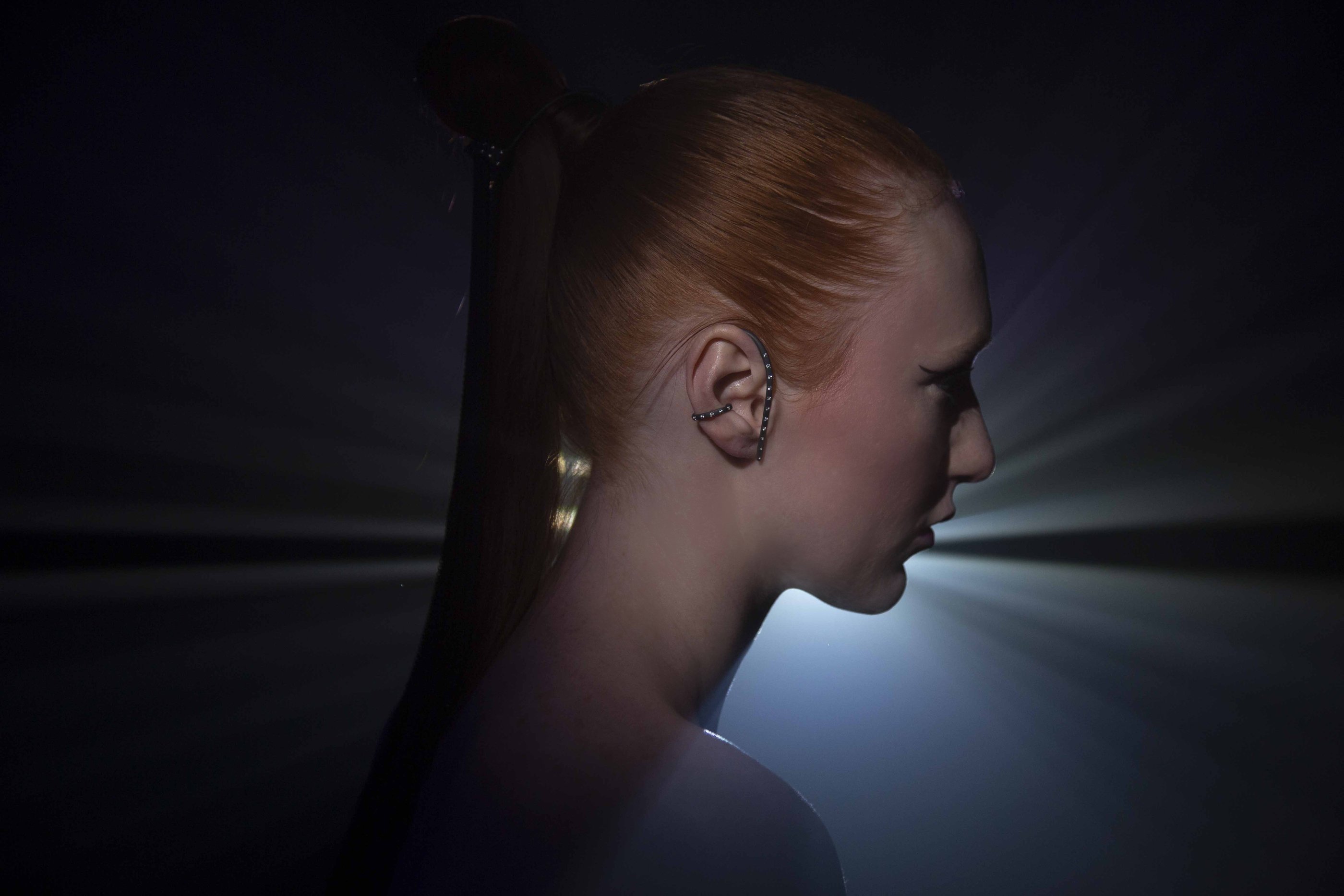

Gaelle Khouri’s thoughts on beauty
aelle Khouri was born in Beirut, Lebanon. Her original goal was to become an economist, and with this in mind she left her country and went to study in New York. After graduation, she secured an internship at Oscar de la Renta, then joined the business development team of Toyota in New York, before returning to Beirut, where she was hired by an investment bank. But finance was not her destiny. By chance, she met the Lebanese artist Bernard Renno, who taught her jewellery design. After a few months, her decision was made: she would radically change her career and opt for jewellery, to give her many ideas material form.
-

- Gaelle Khouri
She started to develop her jewellery-making skills in workshops in Beirut, and created her first jewellery in 2015. She started out using a variety of metals including bronze, silver and gold. One of her first rings, called Bouquet, has a unique beauty precisely because of the mix of materials: it looks as if it comes from an undefined time, perhaps from the land of the fairies or the forest of Brocéliande. “I mixed metals because I didn’t have the money to do otherwise, I didn’t know the industry. But as it enriched the pieces aesthetically, I simply continued,” explains the artist, who presented her latest collection, La Trahison de l’Objet, at the GemGenève 2022 exhibition.
Gaelle Khouri creates in an instinctive, organic way. Her work is not just beautiful, it also exercises the intellect. Some of her jewellery featuring geometric and asymmetrical shapes was inspired by the work of Vassily Kandinsky, who was himself inspired by Rudolf Steiner. Their harmoniously interlocking yet unbalanced circles create the impression of complex geometric equations performed in three dimensions.
-

- Le Bouquet Ring, a cocktail ring, designed in 18K yellow gold and rust-toned bronze, lending the piece a vintage appeal. The delicate flowers are set with white, brown, and yellow diamonds; blue, yellow, and pink sapphires, and green tsavorites.
Her latest collection moves away from abstraction to embrace a more concrete question. “I tried to explore the concept of beauty. What is beauty? Why do we find an object beautiful? Is it simply an aesthetic response, or is there a hidden reason, a psychological and logical component that runs through the mind as we look at an object?”
-

- Self Portrait earrings carved in gold and sterling silver, set with diamonds.
How do you feel when you look at her spider brooch, whose amethyst body is mounted on thin yellow gold and blackened silver legs? Or her earrings in the shape of half-dead fish, called Self Portrait? Do you feel attraction or repulsion? “There is something very beautiful, but at the same time very ugly about them, which scares me. In my subconscious I try to escape from the idea of death, of illness, but by confronting it – and this is a difficult process – I see a certain beauty. There is a point where the beautiful and the ugly mix.”
The jeweller is passionate about philosophy. She likes to explore abstract concepts, and she does so through her jewellery. Behind her latest collection are two opposing currents of philosophical thought: empiricism and innatism. “According to empiricism, we are born without knowledge and acquire it through experience,” she explains. “Innatism proposes that you are born with a fixed truth embedded in your mind. But the two schools of thought agree on one point: when we look at an object, there’s always some external reason why we identify it as beautiful. Either we have already experienced the concept of beauty, or we have it innately, but in both cases we recognise it. That’s the mindset I was in when I created this collection.”
Can beauty exist in the absence of good? “While designing, I questioned the concept of good and evil. Today, everything that is justified becomes good in one way or another. The line between the two doesn’t really exist anymore. I asked myself how people today interpret the concepts of good and evil, and from there I moved on to a question about beauty – how do good and beautiful relate to each other?”
Throughout our meeting, we talked about Descartes, Wassily Kandinsky’s “Concerning the Spiritual in Art – and Painting in Particular”, François Cheng’s “The Way of Beauty: Five Meditations for Spiritual Transformation”, Rudolf Steiner’s research, various philosophical currents, mathematics, synaesthesia and intangible beauty. After that, you can’t tell us that jewellery is trivial.
-

- Crafted in 18K rose gold, the Soleil Vert Earrings are set with chalcedony and brown diamonds.

Saurabh Bhola gives new life to ancient stones
aurabh Bola was born into gemstones. His family has created jewellery for generations, and it never occurred to him to do anything else. He studied jewellery design at the Fashion Institute of Technology in New York under Maurice Galli, head of the Harry Winston creative team. After graduation, he was spotted by Tiffany & Co. He began designing for the brand, but duty called him back to India to work in the family business. He put aside his dream of inventing his own pieces and infusing them with a contemporary spirit to create traditional jewellery. The only problem was, a calling like his demands to be heard – it rejects silence and oblivion.
-

- Saurabh Bola at the Designer Vivarium, GemGenève 2022
- ©David Fraga
In 2018, upon discovering an antique Navratna bracelet of royal provenance, Saurabh Bola had a revelation: the ancient stones on the bracelet were longing for a new life, and he was the one to give it to them. His first collection, launched in autumn 2019 and called Metamorphosis, is an ode to nature. It earned him the Centurion Emerging Designer of the Year award in 2020. He also presented the collection at GemGenève in the Designer Vivarium, where his jewellery clearly exerted a strong pull on visitors. His pieces all have a story to tell; they want you to stop for a moment and listen.
The young Indian jeweller’s creations are a precious tribute to ancient stones and changing nature, as he explains: “Nature is constantly changing, but I try to capture certain fleeting moments: the moment when a leaf falls from a tree, for example. One second it’s there, the next it’s gone. But I am a witness to that moment. It’s the same with a flower: it’s beautiful when it’s in bud, when it’s blooming, but also when it’s fading.”
“Nature is constantly changing, but I try to capture certain fleeting moments.”
When you look closely at his jewellery, you have the feeling that he creates with all his senses: the eyes, the touch, but also the ears. When you look at a flower ring set with an emerald, you think you can see it dancing, just as you can imagine the ceramic petals of his sweet pea brooch fluttering gently.
Saurabh Bola knows how to listen to the silent stories that the stones, and everything around him, whisper to him. He has a very idiosyncratic way of creating. First, his raw materials are all sourced from the family business’s stock of treasures. When an old jewel, gemstone or material inspires him, even if he doesn’t know yet what he will do with it, he sets it aside and waits for inspiration to strike. “Look at this pair of earrings set with ancient natural pearls that belonged to a powerful dynasty: they were set in a very traditional way. I looked at them for a long time and I had the feeling that they were calling out to me that they wanted a modern home. That’s what I did: I gave them a new life.”
Saurabh Bola knows how to listen to the silent stories that the stones, and everything around him, whisper to him.
Gemstones fascinate him. He can stand still indefinitely, gazing at a Zambian emerald, observing its inclusions and its unique imperfections. “It is a dialogue between the stone and me. I am hypnotised: it puts me in a state of euphoria in which I let myself be absorbed,” he explains. He points to a beetle set with a Golconda diamond. “The first time I saw a scarab I was in South India, near the Golconda mines. When I created this beetle, I thought: what if I used a Golconda diamond that belonged to my family? It was set in a ring but it didn’t want to stay there. Its provenance is prestigious. It wanted to be seen, loved, and worn by someone who would appreciate it.”
-

- This sweet pea brooch is designed in a revolutionary soft pink ceramic.
On a presentation tray, a soft pink ceramic sweet pea radiates delicacy. Its material is the result of extensive research and is virtually indestructible. “When I was young, I used to go to the market with my grandfather and we would bring back armfuls of sweet-smelling flowers. I didn’t know their names then, but the bouquet would include tuberose and sweet peas. My grandfather would arrange them near a fan so that the fragrance would fill the room. He is no longer with us, but I created this piece to immortalise a memory. I’ve reached a point where I want to feel free, without outside influence: a blank canvas. When I create jewellery, I set myself free.”
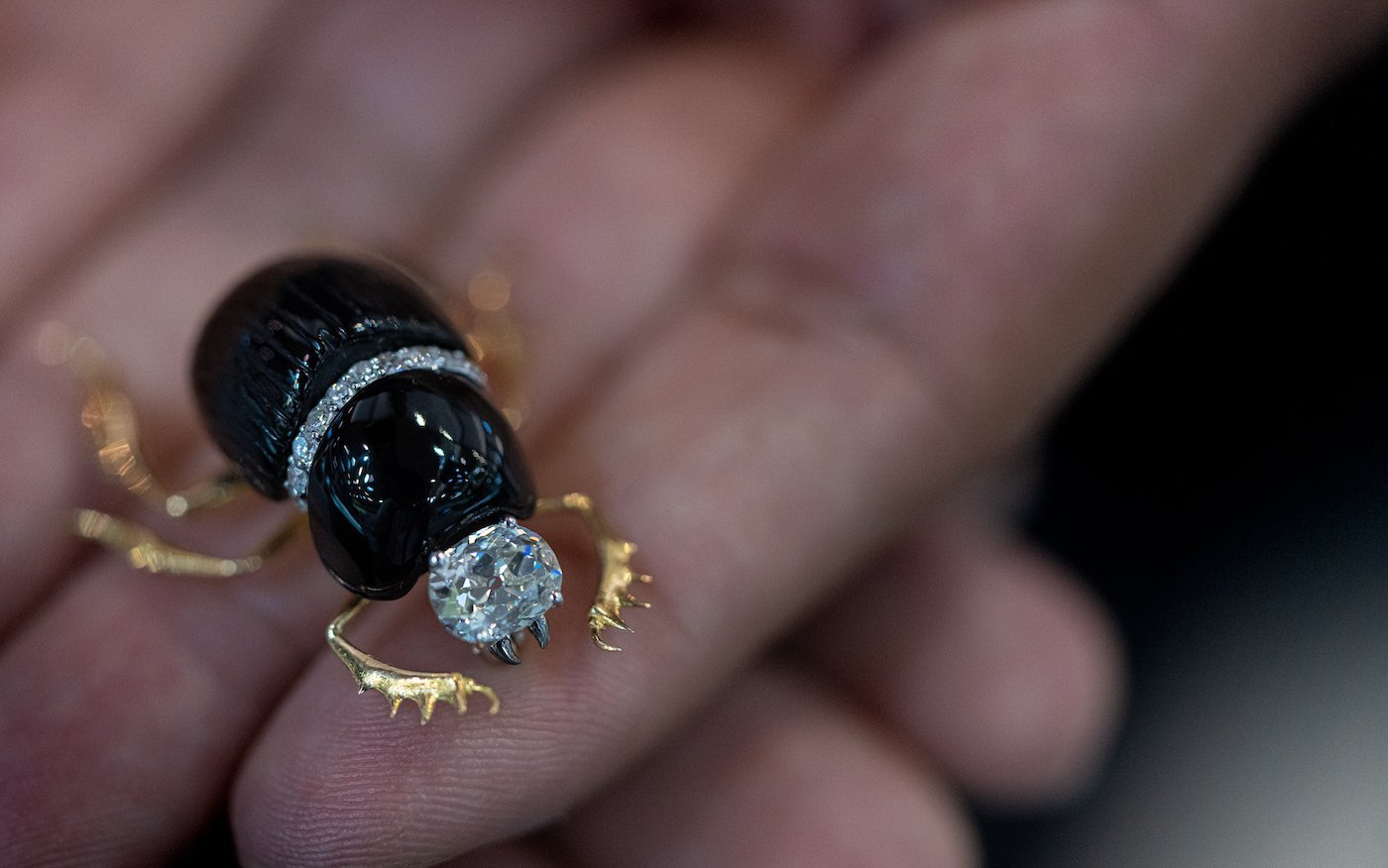

Alexandra Jefford: jewellery that feeds the mind
hen you look at Alexandra Jefford’s jewellery, it’s impossible not to make a connection with the art world, which is in fact where she comes from. A designer, painter and illustrator, Alexandra Jefford was born and educated in Geneva before moving to London to study fine art at Central Saint Martins.
-

- The Duality Ring Camelot
Her specialities are engraving and drawing, but to tell all her inner stories, she felt the need to add a new medium to her artistic palette: jewellery. She studied jewellery design at the Gemological Institute of America and gemmology at the Gemmological Association of Great Britain, and in 2002 she launched her first creations.
Her specialities are engraving and drawing, but to tell all her inner stories, she felt the need to add a new medium to her artistic palette: jewellery.
The influence of Bauhaus and early 20th century abstract art can be seen in her collections. Alexandra Jefford also pays homage to Kasimir Malevitch, whose black square she interpreted in a ring that she presented, among other creations, at the GemGenève exhibition in November 2021.
When asked to explain her vision of jewellery, the artist’s answer provides the key that opens the door to her creative universe: “I draw, I paint, I sculpt, I have always worked in a visual context, that of shapes, textures and colours. Jewellery is at the crossroads of all these paths. There is also another dimension to jewellery: in addition to its visual aspect, we become emotionally attached to it. You take the time to look at it, you wear it. It has a talismanic dimension where the person you are, as well as the person who gave it to you, play a role... Jewellery, in that sense, has a lot of power.”
-

- The Duality Ring Camelot
The first piece Alexandra Jefford created – a diamond ring, which she sold to a friend – was the hardest to let go of. But then she created another piece of jewellery, which she then sold, allowing her to create yet another, and so on. Because she doesn’t advertise, doesn’t promote herself and refuses to be categorised as a “jewellery designer”, it took a while for people to realise that something new was happening in her London studio.
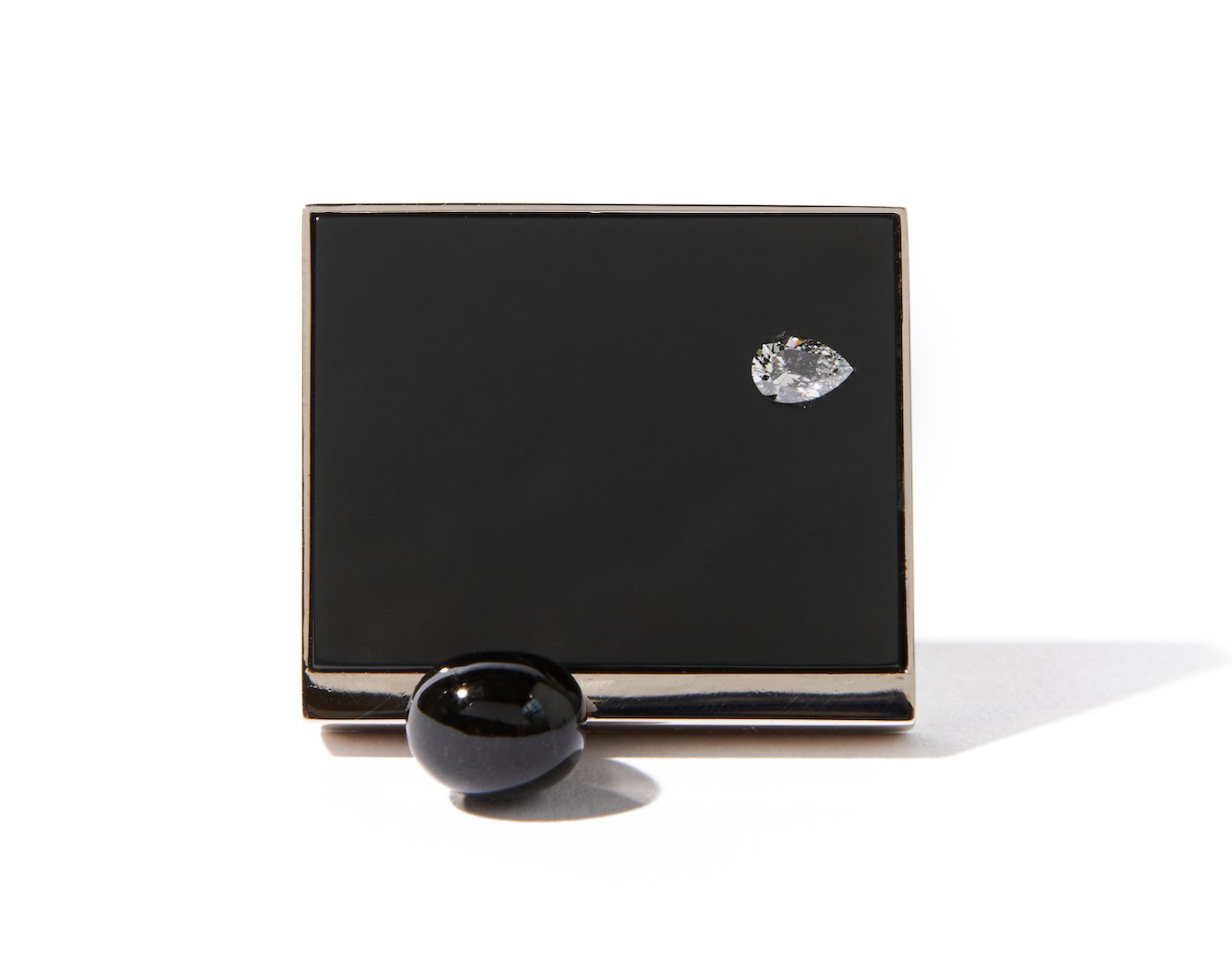
Gradually she began to receive commissions, from private clients but also from institutional actors including the Victoria & Albert Museum and the Smythson Company, for whom she designed a series of rings on the theme of love. She has exhibited at galleries and art fairs in London, Paris and Miami. Her jewellery is unique. One of her rings has an extra dimension: in addition to its role as an ornament and an object of beauty, it is also an aid to meditation. “I do a lot of yoga, and I know many people who meditate with crystals or stones. That inspired me to create this ring: when you meditate, you turn it upside down, let the stone rest in your palm, and you start to enter into silence. I’m very keen to create a whole series with different kinds of stones. Of course, some people don’t believe in the energy of stones, but that doesn’t matter.” The beauty of the object itself is beyond debate.
One of her rings has an extra dimension: in addition to its role as an ornament and an object of beauty, it is also an aid to meditation.
-

- The Meditation Ring
Alexandra Jefford hates it when people talk about her jewellery as wearable art. In reality, it’s much more than that. Although it’s an artistic object, that’s not all it is: it can also be a talisman, helping people in their spiritual practice. It’s also an expression of the artist’s dual culture. A piece of jewellery has both a static and a fluid aspect. It combines the sober and the playful, the monochrome and the coloured, the symbolic and the material. In the end, this is jewellery that feeds the mind.

Atelier Allure: in praise of shadows
telier Allure’s jewellery is to be observed with an unprejudiced eye, on the understanding that the value of an object is not always immediately visible, and cannot be limited to the price of a rare gemstone or precious metal. In his quest to shape the jewellery of his dreams, Thomas Hauser went as far as inventing a new metal – called Niellium. His creations embody his desire to create sculpted forms that strive for purity.
Thomas Hauser completed an apprenticeship as a goldsmith in Austria and, at the age of 21, went to work in Paris, where he learned to make jewellery, precious clocks, and other objects for major houses such as Cartier and Asprey. Then he moved to New York, where he worked in the fashion industry, developing accessories for Calvin Klein and Donna Karan. But he was obsessed with creating pieces that embodied his own philosophy, so in 1998 he founded Atelier Allure in New York.
-

- Thomas Hauser
“I wanted to create my own collections and put my experimental approach to materials into practice,” Thomas Hauser emphasises. To achieve this, he became a metallurgist, a craftsman, an artist, a jeweller and an alchemist.
When we point out to him that his work is reminiscent of Jun’ichirō Tanizaki’s In Praise of Shadows, a wonderful analysis of Japanese aesthetics that places a high value on patina, he enthuses: “It’s my bedside book! In the West, people worship light, whereas in Japan they cherish shadow.” Jewellery is an art of light: a diamond is cut in such a way as to reflect and refract the maximum amount of light; precious metals are polished and set to ensure they shine with a thousand lights. But Thomas Hauser was looking for the exact opposite: to reveal the shadows.
-

- Thomas Hauser has developed his own alloy, called Niellium, to craft the jewellery of his dreams in deep black.
Jewellery is an art of light: a diamond is cut in such a way as to reflect and refract the maximum amount of ligh. But Thomas Hauser was looking for the exact opposite: to reveal the shadows.
While teaching at the Fashion Institute of Technology in New York, his research led to the development of Niellium, a metal made of platinum, palladium and silver that was intrinsically dark, without surface treatment. To do this, he took up work carried out 40 years ago by a researcher who went looking for a blue material, but ended up with black. This intrigued Thomas Hauser. “I looked for what I had to change to develop a material I could work with. This process took me seven years, with the support of scientists. I called it Niellium after ‘niello,’ an alloy used in goldsmithing to produce a black cloisonne effect.”
His research led to the development of Niellium, a metal made of platinum, palladium and silver that was intrinsically dark, without surface treatment.
While it looked perfect, Niellium was difficult to work with. For years, the jeweller sought to tame the material, creating new ways to polish, texture and set it. His work has won numerous awards, including the Red Dot Award, the iF-Award and the Good Design Award. His rings are intriguing. “Their asymmetry means that you can’t fully grasp them at a glance,” explains Thomas Hauser. “You have to come back to them several times, looking closer and closer. That’s how you develop an emotional connection.”
